Assessing Above-Ground Biomass Dynamics and Carbon Sequestration Potential Using Machine Learning and Spaceborne LiDAR in Hilly Conifer Forests of Mansehra District, Pakistan
Abstract
1. Introduction
2. Materials and Methods
2.1. Study Area
2.2. Datasets
2.2.1. Forest Territorial Distribution and Compartment Data
2.2.2. Field Inventory Data
2.2.3. Satellite Datasets
Digital Elevation Model
Forest Layer
Forest Height
Predictor Variables
2.2.4. CO2 Emission Dataset
2.3. Data Preparation and Analytical Workflow
2.3.1. Data Processing
2.3.2. Analytical Workflow
2.3.3. Parameter Selection
3. Results
3.1. Explanatory Variable Evaluation
3.2. Model Selection and Accuracy Assessment
3.3. Above-Ground Biomass Distribution in Designated Forests
3.3.1. Reserved Forests
3.3.2. Protected Forests
3.3.3. Community (Guzara) Forests
3.4. Ecological Analysis of Forest Cover and Biomass Dynamics in Mansehra
4. Discussion
4.1. Accuracy Analysis
4.2. Comparison of Biomass Estimates
4.3. AGB Potential and CO2 Sequestration
5. Conclusions
Author Contributions
Funding
Data Availability Statement
Acknowledgments
Conflicts of Interest
References
- Sung, H.M.; Kim, J.; Shim, S.; Seo, J.B.; Kwon, S.H.; Sun, M.A.; Moon, H.; Lee, J.H.; Lim, Y.J.; Boo, K.O.; et al. Climate Change Projection in the Twenty-First Century Simulated by NIMS-KMA CMIP6 Model Based on New GHGs Concentration Pathways. Asia Pac. J. Atmos. Sci. 2021, 57, 851–862. [Google Scholar] [CrossRef]
- Liu, Z.; Deng, Z.; Davis, S.J.; Ciais, P. Global Carbon Emissions in 2023. Nat. Rev. Earth Environ. 2024, 5, 253–254. [Google Scholar] [CrossRef]
- Forzieri, G.; Dakos, V.; Mcdowell, N.G.; Ramdane, A.; Cescatti, A. Emerging Signals of Declining Forest Resilience under Climate Change. Nature 2022, 608, 534–539. [Google Scholar] [CrossRef]
- Vijitharan, S.; Sasaki, N.; Tripathi, N.K.; Pramanik, M.; Tsusaka, T.W. Assessing Carbon Emission Reductions and Removals in Vavuniya District, Sri Lanka: REDD+ Project Contributions to Sustainability. Next Sustain. 2024, 3, 100035. [Google Scholar] [CrossRef]
- Adnan, M.; Xiao, B.; Bibi, S.; Xiao, P.; Zhao, P.; Wang, H. Addressing Current Climate Issues in Pakistan: An Opportunity for a Sustainable Future. Environ. Chall. 2024, 15, 100887. [Google Scholar] [CrossRef]
- Khan, I.A.; Khan, W.R.; Ali, A.; Nazre, M. Assessment of Above-Ground Biomass in Pakistan Forest Ecosystem’s Carbon Pool: A Review. Forests 2021, 12, 586. [Google Scholar] [CrossRef]
- Walker, W.S.; Gorelik, S.R.; Cook-Patton, S.C.; Baccini, A.; Farina, M.K.; Solvik, K.K.; Ellis, P.W.; Sanderman, J.; Houghton, R.A.; Leavitt, S.M.; et al. The Global Potential for Increased Storage of Carbon on Land. Proc. Natl. Acad. Sci. USA 2022, 119, e2111312119. [Google Scholar] [CrossRef] [PubMed]
- Rawat, M.; Arunachalam, K.; Arunachalam, A.; Alatalo, J.M.; Kumar, U.; Simon, B.; Hufnagel, L.; Micheli, E.; Pandey, R. Relative Contribution of Plant Traits and Soil Properties to the Functioning of a Temperate Forest Ecosystem in the Indian Himalayas. Catena 2020, 194, 104671. [Google Scholar] [CrossRef]
- Gajendiran, K.; Kandasamy, S.; Narayanan, M. Influences of Wildfire on the Forest Ecosystem and Climate Change: A Comprehensive Study. Environ. Res. 2024, 240, 117537. [Google Scholar] [CrossRef]
- Petrokofsky, G.; Kanamaru, H.; Achard, F.; Goetz, S.J.; Joosten, H.; Holmgren, P.; Lehtonen, A.; Menton, M.C.; Pullin, A.S.; Wattenbach, M. Comparison of Methods for Measuring and Assessing Carbon Stocks and Carbon Stock Changes in Terrestrial Carbon Pools. How Do the Accuracy and Precision of Current Methods Compare? A Systematic Review Protocol. Environ. Evid. 2012, 1, 6. [Google Scholar] [CrossRef]
- Musthafa, M.; Singh, G. Forest Above-Ground Woody Biomass Estimation Using Multi-Temporal Space-Borne LiDAR Data in a Managed Forest at Haldwani, India. Adv. Space Res. 2022, 69, 3245–3257. [Google Scholar] [CrossRef]
- Manley, K.; Nyelele, C.; Egoh, B.N. A Review of Machine Learning and Big Data Applications in Addressing Ecosystem Service Research Gaps. Ecosyst. Serv. 2022, 57, 101478. [Google Scholar] [CrossRef]
- Zhang, Y.; Liang, S.; Yang, L. A Review of Regional and Global Gridded Forest Biomass Datasets. Remote Sens. 2019, 11, 2744. [Google Scholar] [CrossRef]
- Tang, G.; Beckage, B.; Smith, B.; Miller, P.A. Estimating Potential Forest NPP, Biomass and Their Climatic Sensitivity in New England Using a Dynamic Ecosystem Model. Ecosphere 2010, 1, 1–20. [Google Scholar] [CrossRef]
- Ali, A.; Ashraf, M.I.; Gulzar, S.; Akmal, M. Development of an Allometric Model for Biomass Estimation of Pinus Roxberghii, Growing in Subtropical Pine Forests of Khyber Pakhtunkhwa, Pakistan. Sarhad J. Agric. 2020, 36, 236–244. [Google Scholar] [CrossRef]
- Khan, K.; Iqbal, J.; Ali, A.; Khan, S.N. Assessment of Sentinel-2-Derived Vegetation Indices for the Estimation of Above-Ground Biomass/Carbon Stock, Temporal Deforestation and Carbon Emissions Estimation in the Moist Temperate Forests of Pakistan. Appl. Ecol. Environ. Res. 2020, 18, 783–815. [Google Scholar] [CrossRef]
- Amjad, D.; Kausar, S.; Waqar, R.; Sarwar, F. Land Cover Change Analysis and Impacts of Deforestation on the Climate of District Mansehra, Pakistan. J. Biodivers. Environ. Sci. 2020, 103, 103–113. [Google Scholar] [CrossRef]
- Spawn, S.A.; Sullivan, C.C.; Lark, T.J.; Gibbs, H.K. Harmonized Global Maps of above and Belowground Biomass Carbon Density in the Year 2010. Sci. Data 2020, 7, 112. [Google Scholar] [CrossRef] [PubMed]
- Dubayah, R.; Blair, J.B.; Goetz, S.; Fatoyinbo, L.; Hansen, M.; Healey, S.; Hofton, M.; Hurtt, G.; Kellner, J.; Luthcke, S.; et al. The Global Ecosystem Dynamics Investigation: High-Resolution Laser Ranging of the Earth’s Forests and Topography. Sci. Remote Sens. 2020, 1, 100002. [Google Scholar] [CrossRef]
- Kumar, L.; Mutanga, O. Remote Sensing of Above-Ground Biomass. Remote Sens. 2017, 9, 935. [Google Scholar] [CrossRef]
- Holcomb, A.; Mathis, S.V.; Coomes, D.A.; Keshav, S. Computational Tools for Assessing Forest Recovery with GEDI Shots and Forest Change Maps. Sci. Remote Sens. 2023, 8, 100106. [Google Scholar] [CrossRef]
- Bullock, E.L.; Healey, S.P.; Yang, Z.; Acosta, R.; Villalba, H.; Insfrán, K.P.; Melo, J.B.; Wilson, S.; Duncanson, L.; Næsset, E.; et al. Estimating Aboveground Biomass Density Using Hybrid Statistical Inference with GEDI Lidar Data and Paraguay’s National Forest Inventory. Environ. Res. Lett. 2023, 18, 085001. [Google Scholar] [CrossRef]
- Musthafa, M.; Singh, G.; Kumar, P. Comparison of Forest Stand Height Interpolation of GEDI and ICESat-2 LiDAR Measurements over Tropical and Sub-Tropical Forests in India. Environ. Monit. Assess. 2023, 195, 71. [Google Scholar] [CrossRef] [PubMed]
- Indirabai, I.; Nilsson, M. Estimation of above Ground Biomass in Tropical Heterogeneous Forests in India Using GEDI. Ecol. Inf. 2024, 82, 102712. [Google Scholar] [CrossRef]
- Yang, Q.; Niu, C.; Liu, X.; Feng, Y.; Ma, Q.; Wang, X.; Tang, H.; Guo, Q. Mapping High-Resolution Forest Aboveground Biomass of China Using Multisource Remote Sensing Data. GISci. Remote Sens. 2023, 60, 2203303. [Google Scholar] [CrossRef]
- Nandy, S.; Srinet, R.; Padalia, H. Mapping Forest Height and Aboveground Biomass by Integrating ICESat-2, Sentinel-1 and Sentinel-2 Data Using Random Forest Algorithm in Northwest Himalayan Foothills of India. Geophys. Res. Lett. 2021, 48, e2021GL093799. [Google Scholar] [CrossRef]
- Forkuor, G.; Benewinde Zoungrana, J.B.; Dimobe, K.; Ouattara, B.; Vadrevu, K.P.; Tondoh, J.E. Above-Ground Biomass Mapping in West African Dryland Forest Using Sentinel-1 and 2 Datasets—A Case Study. Remote Sens. Environ. 2020, 236, 111496. [Google Scholar] [CrossRef]
- Fayad, I.; Baghdadi, N.; Guitet, S.; Bailly, J.S.; Hérault, B.; Gond, V.; El Hajj, M.; Tong Minh, D.H. Aboveground Biomass Mapping in French Guiana by Combining Remote Sensing, Forest Inventories and Environmental Data. Int. J. Appl. Earth Obs. Geoinf. 2016, 52, 502–514. [Google Scholar] [CrossRef]
- Zhao, X.; Hu, W.; Han, J.; Wei, W.; Xu, J. Urban Above-Ground Biomass Estimation Using GEDI Laser Data and Optical Remote Sensing Images. Remote Sens. 2024, 16, 1229. [Google Scholar] [CrossRef]
- Duncanson, L.; Kellner, J.R.; Armston, J.; Dubayah, R.; Minor, D.M.; Hancock, S.; Healey, S.P.; Patterson, P.L. Aboveground Biomass Density Models for NASA’s Global Ecosystem Dynamics Investigation (GEDI) Lidar Mission. Remote Sens. Environ. 2022, 270, 112845. [Google Scholar] [CrossRef]
- Xu, L.; Yu, J.; Shu, Q.; Luo, S.; Zhou, W.; Duan, D. Forest Aboveground Biomass Estimation Based on Spaceborne LiDAR Combining Machine Learning Model and Geostatistical Method. Front. Plant Sci. 2024, 15, 1428268. [Google Scholar] [CrossRef]
- Torre-Tojal, L.; Bastarrika, A.; Boyano, A.; Lopez-Guede, J.M.; Graña, M. Above-Ground Biomass Estimation from LiDAR Data Using Random Forest Algorithms. J. Comput. Sci. 2022, 58, 101517. [Google Scholar] [CrossRef]
- Forest, M.; Wang, C.; Datcu, M.P.; Tang, Y.; Tian, S.; Tian, X.; Li, J.; Zhang, F.; Zhang, H.; Jiang, M. Forest Aboveground Biomass Estimation Using Multisource Remote Sensing Data and Deep Learning Algorithms: A Case Study over Hangzhou Area in China. Remote Sens. 2024, 16, 1074. [Google Scholar] [CrossRef]
- Cheng, F.; Ou, G.; Wang, M.; Liu, C. Remote Sensing Estimation of Forest Carbon Stock Based on Machine Learning Algorithms. Forests 2024, 15, 681. [Google Scholar] [CrossRef]
- Zhang, X.; Shen, H.; Huang, T.; Wu, Y.; Guo, B.; Liu, Z.; Luo, H.; Tang, J.; Zhou, H.; Wang, L.; et al. Improved Random Forest Algorithms for Increasing the Accuracy of Forest Aboveground Biomass Estimation Using Sentinel-2 Imagery. Ecol. Indic. 2024, 159, 111752. [Google Scholar] [CrossRef]
- Wang, E.; Huang, T.; Liu, Z.; Bao, L.; Guo, B.; Yu, Z.; Feng, Z.; Luo, H.; Ou, G. Improving Forest Above-Ground Biomass Estimation Accuracy Using Multi-Source Remote Sensing and Optimized Least Absolute Shrinkage and Selection Operator Variable Selection Method. Remote Sens. 2024, 16, 4497. [Google Scholar] [CrossRef]
- Anees, S.A.; Mehmood, K.; Khan, W.R.; Sajjad, M.; Alahmadi, T.A.; Alharbi, S.A.; Luo, M. Integration of Machine Learning and Remote Sensing for above Ground Biomass Estimation through Landsat-9 and Field Data in Temperate Forests of the Himalayan Region. Ecol. Inform. 2024, 82, 102732. [Google Scholar] [CrossRef]
- Ali, A.; Ashraf, M.I.; Gulzar, S.; Akmal, M. Estimation of Forest Carbon Stocks in Temperate and Subtropical Mountain Systems of Pakistan: Implications for REDD+ and Climate Change Mitigation. Environ. Monit. Assess. 2020, 192, 198. [Google Scholar] [CrossRef] [PubMed]
- Shahzad, N.; Saeed, U.; Gilani, H.; Ahmad, S.R.; Ashraf, I.; Irteza, S.M. Evaluation of State and Community/Private Forests in Punjab, Pakistan Using Geospatial Data and Related Techniques. For. Ecosyst. 2015, 2, 7. [Google Scholar] [CrossRef]
- Nizami, S.M. The Inventory of the Carbon Stocks in Sub Tropical Forests of Pakistan for Reporting under Kyoto Protocol. J. Res. 2012, 23, 377–384. [Google Scholar] [CrossRef]
- Masek, J.G.; Wulder, M.A.; Markham, B.; McCorkel, J.; Crawford, C.J.; Storey, J.; Jenstrom, D.T. Landsat 9: Empowering Open Science and Applications through Continuity. Remote Sens. Environ. 2020, 248, 111968. [Google Scholar] [CrossRef]
- Lu, D.; Chen, Q.; Wang, G.; Liu, L.; Li, G.; Moran, E. A Survey of Remote Sensing-Based Aboveground Biomass Estimation Methods in Forest Ecosystems. Int. J. Digit. Earth 2016, 9, 63–105. [Google Scholar] [CrossRef]
- Potapov, P.; Li, X.; Hernandez-Serna, A.; Tyukavina, A.; Hansen, M.C.; Kommareddy, A.; Pickens, A.; Turubanova, S.; Tang, H.; Silva, C.E.; et al. Mapping Global Forest Canopy Height through Integration of GEDI and Landsat Data. Remote Sens. Environ. 2021, 253, 112165. [Google Scholar] [CrossRef]
- Zhu, X.; Liu, D. Improving Forest Aboveground Biomass Estimation Using Seasonal Landsat NDVI Time-Series. ISPRS J. Photogramm. Remote Sens. 2015, 102, 222–231. [Google Scholar] [CrossRef]
- David, R.M.; Rosser, N.J.; Donoghue, D.N.M. Improving above Ground Biomass Estimates of Southern Africa Dryland Forests by Combining Sentinel-1 SAR and Sentinel-2 Multispectral Imagery. Remote Sens. Environ. 2022, 282, 113232. [Google Scholar] [CrossRef]
- Nandy, S.; Kushwaha, S.P.S. Forest Biomass Assessment Integrating Field Inventory and Optical Remote Sensing Data: A Systematic Review. Int. J. Plant Environ. 2021, 7, 181–186. [Google Scholar] [CrossRef]
- Alexandridis, T.; Perakis, K. Vegetation Indices: Advances Made in Biomass Estimation and Vegetation Monitoring in the Last 30 Years. Geocarto Int. 2006, 21, 21–28. [Google Scholar]
- Centre, E.C.J.R.; Crippa, M.; Guizzardi, D.; Pagani, F.; Banja, M.; Muntean, M.; Schaaf, E.; Monforti-Ferrario, F.; Becker, W.; Quadrelli, R.; et al. GHG Emissions of All World Countries; Publications Office of the European Union: Luxembourg, 2024. [Google Scholar]
- Bichri, H.; Chergui, A.; Hain, M. Investigating the Impact of Train/Test Split Ratio on the Performance of Pre-Trained Models with Custom Datasets. Int. J. Adv. Comput. Sci. Appl. 2024, 15, 331. [Google Scholar] [CrossRef]
- Hasan, L. An Anatomy of State Failures in Forest Management in Pakistan. In Pakistan Development Review; Pakistan Institute of Development Economics: Islamabad, Pakistan, 2007; Volume 46. [Google Scholar]
- Wang, C.; Zhang, W.; Ji, Y.; Marino, A.; Li, C.; Wang, L.; Zhao, H.; Wang, M. Estimation of Aboveground Biomass for Different Forest Types Using Data from Sentinel-1, Sentinel-2, ALOS PALSAR-2, and GEDI. Forests 2024, 15, 215. [Google Scholar] [CrossRef]
- Kanmegne Tamga, D.; Latifi, H.; Ullmann, T.; Baumhauer, R.; Bayala, J.; Thiel, M. Estimation of Aboveground Biomass in Agroforestry Systems over Three Climatic Regions in West Africa Using Sentinel-1, Sentinel-2, ALOS, and GEDI Data. Sensors 2022, 23, 349. [Google Scholar] [CrossRef] [PubMed]
- Gao, Y.; Lu, D.; Li, G.; Wang, G.; Chen, Q.; Liu, L.; Li, D. Comparative Analysis of Modeling Algorithms for Forest Aboveground Biomass Estimation in a Subtropical Region. Remote Sens. 2018, 10, 627. [Google Scholar] [CrossRef]
- Li, Y.; Li, C.; Li, M.; Liu, Z. Influence of Variable Selection and Forest Type on Forest Aboveground Biomass Estimation Using Machine Learning Algorithms. Forests 2019, 10, 1073. [Google Scholar] [CrossRef]
- Hoover, C.M.; Smith, J.E. Aboveground Live Tree Carbon Stock and Change in Forests of Conterminous United States: Influence of Stand Age. Carbon Balance Manag. 2023, 18, 7. [Google Scholar] [CrossRef] [PubMed]
- IPCC. 2006 IPCC Guidelines for National Greenhouse Gas Inventories, prepared by the National Greenhouse Gas Inventories Programme; Eggleston, H.S., Buendia, L., Miwa, K., Ngara, T., Tanabe, K., Eds.; IGES: Hayama, Japan, 2006. [Google Scholar]
- Bai, Y.; Ding, G. Estimation of Changes in Carbon Sequestration and Its Economic Value with Various Stand Density and Rotation Age of Pinus Massoniana Plantations in China. Sci. Rep. 2024, 14, 16852. [Google Scholar] [CrossRef] [PubMed]
- Jia, D.; Wang, C.; Hakkenberg, C.R.; Numata, I.; Elmore, A.J.; Cochrane, M.A. Accuracy Evaluation and Effect Factor Analysis of GEDI Aboveground Biomass Product for Temperate Forests in the Conterminous United States. GIsci. Remote Sens. 2023, 61, 2292374. [Google Scholar] [CrossRef]
- Rodda, S.R.; Nidamanuri, R.R.; Fararoda, R.; Mayamanikandan, T.; Rajashekar, G. Evaluation of Height Metrics and Above-Ground Biomass Density from GEDI and ICESat-2 Over Indian Tropical Dry Forests Using Airborne LiDAR Data. J. Indian Soc. Remote Sens. 2024, 52, 841–856. [Google Scholar] [CrossRef]
- Liu, A.; Cheng, X.; Chen, Z. Performance Evaluation of GEDI and ICESat-2 Laser Altimeter Data for Terrain and Canopy Height Retrievals. Remote Sens. Environ. 2021, 264, 112571. [Google Scholar] [CrossRef]
- Zhang, C.; Wang, K.; Yue, Y.; Qi, X.; Zhang, M. Assessing Regional Ecosystem Conditions Using Geospatial Techniques—A Review. Sensors 2023, 23, 4101. [Google Scholar] [CrossRef] [PubMed]
- Dorado-Roda, I.; Pascual, A.; Godinho, S.; Silva, C.A.; Botequim, B.; Rodríguez-Gonzálvez, P.; González-Ferreiro, E.; Guerra-Hernández, J. Assessing the Accuracy of GEDI Data for Canopy Height and Aboveground Biomass Estimates in Mediterranean Forests. Remote Sens. 2021, 13, 2279. [Google Scholar] [CrossRef]
- Rodríguez-Veiga, P.; Quegan, S.; Carreiras, J.; Persson, H.J.; Fransson, J.E.S.; Hoscilo, A.; Ziółkowski, D.; Stereńczak, K.; Lohberger, S.; Stängel, M.; et al. Forest Biomass Retrieval Approaches from Earth Observation in Different Biomes. Int. J. Appl. Earth Obs. Geoinf. 2019, 77, 53–68. [Google Scholar] [CrossRef]
- Sainuddin, F.V.; Malek, G.; Rajwadi, A.; Nagar, P.S.; Asok, S.V.; Reddy, C.S. Estimating Above-Ground Biomass of the Regional Forest Landscape of Northern Western Ghats Using Machine Learning Algorithms and Multi-Sensor Remote Sensing Data. J. Indian Soc. Remote Sens. 2024, 52, 885–902. [Google Scholar] [CrossRef]
- Yang, L.; Liang, S.; Zhang, Y. A New Method for Generating a Global Forest Aboveground Biomass Map from Multiple High-Level Satellite Products and Ancillary Information. IEEE J. Sel. Top. Appl. Earth Obs. Remote Sens. 2020, 13, 2587–2597. [Google Scholar] [CrossRef]
- Hu, T.; Su, Y.; Xue, B.; Liu, J.; Zhao, X.; Fang, J.; Guo, Q. Mapping Global Forest Aboveground Biomass with Spaceborne LiDAR, Optical Imagery, and Forest Inventory Data. Remote Sens. 2016, 8, 565. [Google Scholar] [CrossRef]
- Santoro, M.; Cartus, O.; Carvalhais, N.; Rozendaal, D.M.A.; Avitabile, V.; Araza, A.; De Bruin, S.; Herold, M.; Quegan, S.; Rodríguez-Veiga, P.; et al. The Global Forest Above-Ground Biomass Pool for 2010 Estimated from High-Resolution Satellite Observations. Earth Syst. Sci. Data 2021, 13, 3927–3950. [Google Scholar] [CrossRef]
- Bruening, J.M.; Fischer, R.; Bohn, F.J.; Armston, J.; Armstrong, A.H.; Knapp, N.; Tang, H.; Huth, A.; Dubayah, R. Challenges to Aboveground Biomass Prediction from Waveform Lidar. Environ. Res. Lett. 2021, 16, 125013. [Google Scholar] [CrossRef]
- Labrière, N.; Davies, S.J.; Disney, M.I.; Duncanson, L.I.; Herold, M.; Lewis, S.L.; Phillips, O.L.; Quegan, S.; Saatchi, S.S.; Schepaschenko, D.G.; et al. Toward a Forest Biomass Reference Measurement System for Remote Sensing Applications. Glob. Chang. Biol. 2023, 29, 827–840. [Google Scholar] [CrossRef] [PubMed]
- Campbell, M.J.; Dennison, P.E.; Kerr, K.L.; Brewer, S.C.; Anderegg, W.R.L. Scaled Biomass Estimation in Woodland Ecosystems: Testing the Individual and Combined Capacities of Satellite Multispectral and Lidar Data. Remote Sens. Environ. 2021, 262, 112511. [Google Scholar] [CrossRef]
- Bhandari, K.; Srinet, R.; Nandy, S. Forest Height and Aboveground Biomass Mapping by Synergistic Use of GEDI and Sentinel Data Using Random Forest Algorithm in the Indian Himalayan Region. J. Indian Soc. Remote Sens. 2024, 52, 857–869. [Google Scholar] [CrossRef]
- Fararoda, R.; Reddy, R.S.; Rajashekar, G.; Chand, T.R.K.; Jha, C.S.; Dadhwal, V.K. Improving Forest above Ground Biomass Estimates over Indian Forests Using Multi Source Data Sets with Machine Learning Algorithm. Ecol. Inf. 2021, 65, 101392. [Google Scholar] [CrossRef]
- Qasim, M.; Csaplovics, E. Comparative Study of Forest Biomass and Carbon Stocks of Margalla Hills National Park, Pakistan. For. Sci. Technol. 2023, 19, 139–154. [Google Scholar] [CrossRef]
- Imran, A.B.; Ahmed, S. Potential of Landsat-8 Spectral Indices to Estimate Forest Biomass. Int. J. Hum. Cap. Urban Manag. 2018, 3, 303–314. [Google Scholar] [CrossRef]
- Yusuf, M. Forest Management in Pakistan: A Legal and Institutional Analysis; Sustainable Development Policy Institute (SDPI): Islamabad, Pakistan, 2008. [Google Scholar]
- Ali, A. Forest Reference Emission Level of Khyber Pakhtunkhwa; Pakistan Forest Institute: Peshawar, Pakistan, 2017; pp. 1–54.
- Sharma, C.M.; Baduni, N.P.; Gairola, S.; Ghildiyal, S.K.; Suyal, S. Tree Diversity and Carbon Stocks of Some Major Forest Types of Garhwal Himalaya, India. Ecol. Manag. 2010, 260, 2170–2179. [Google Scholar] [CrossRef]
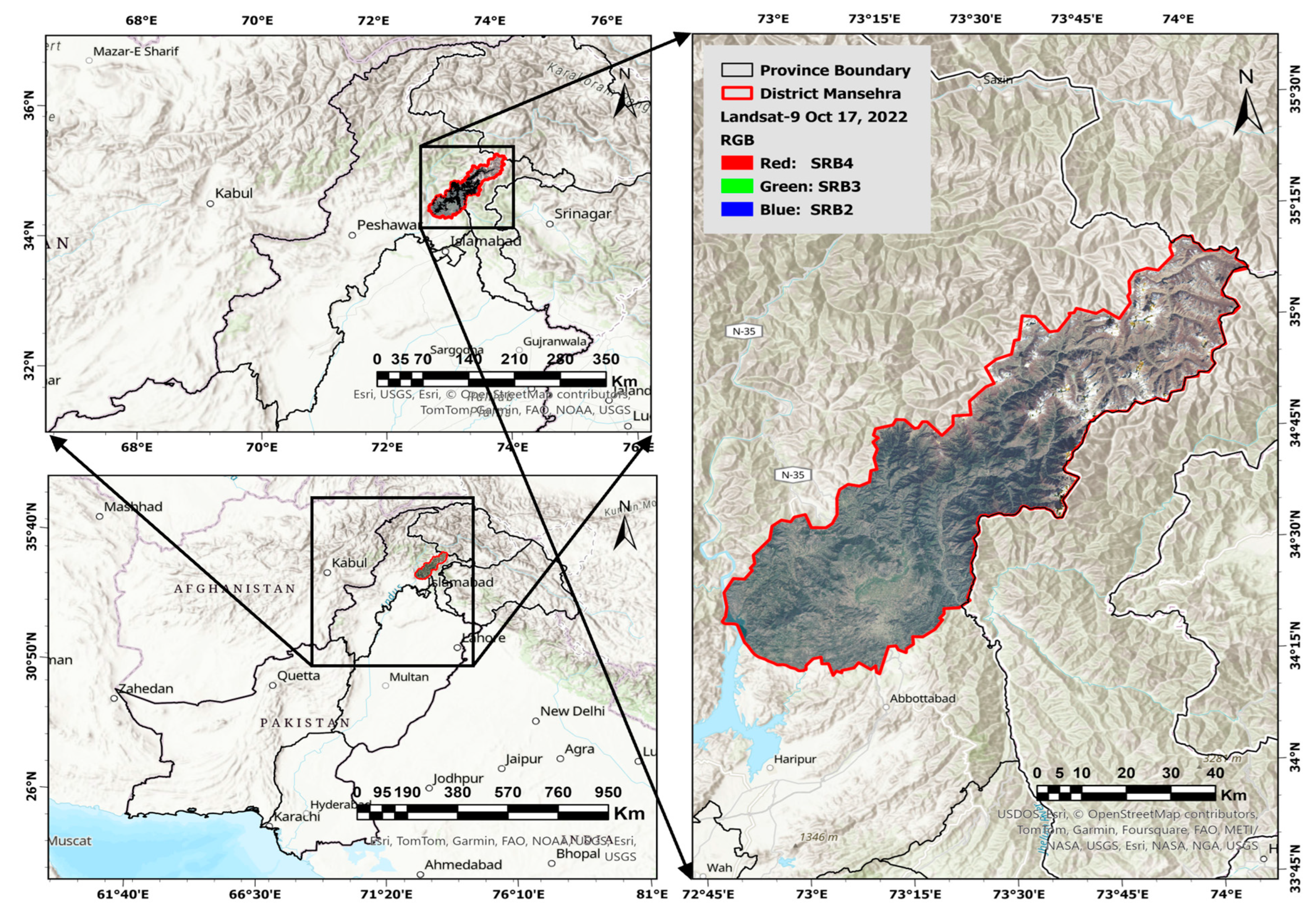
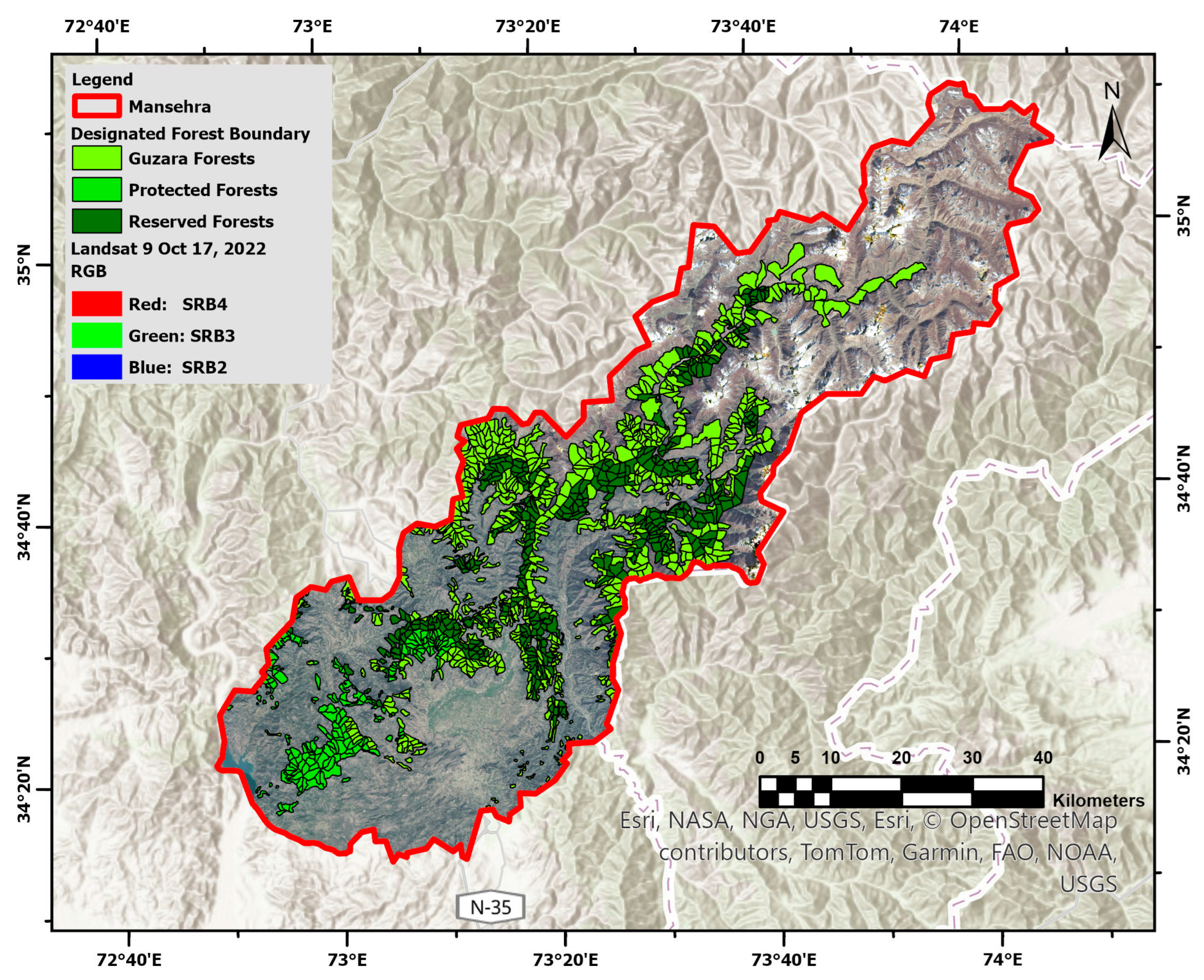

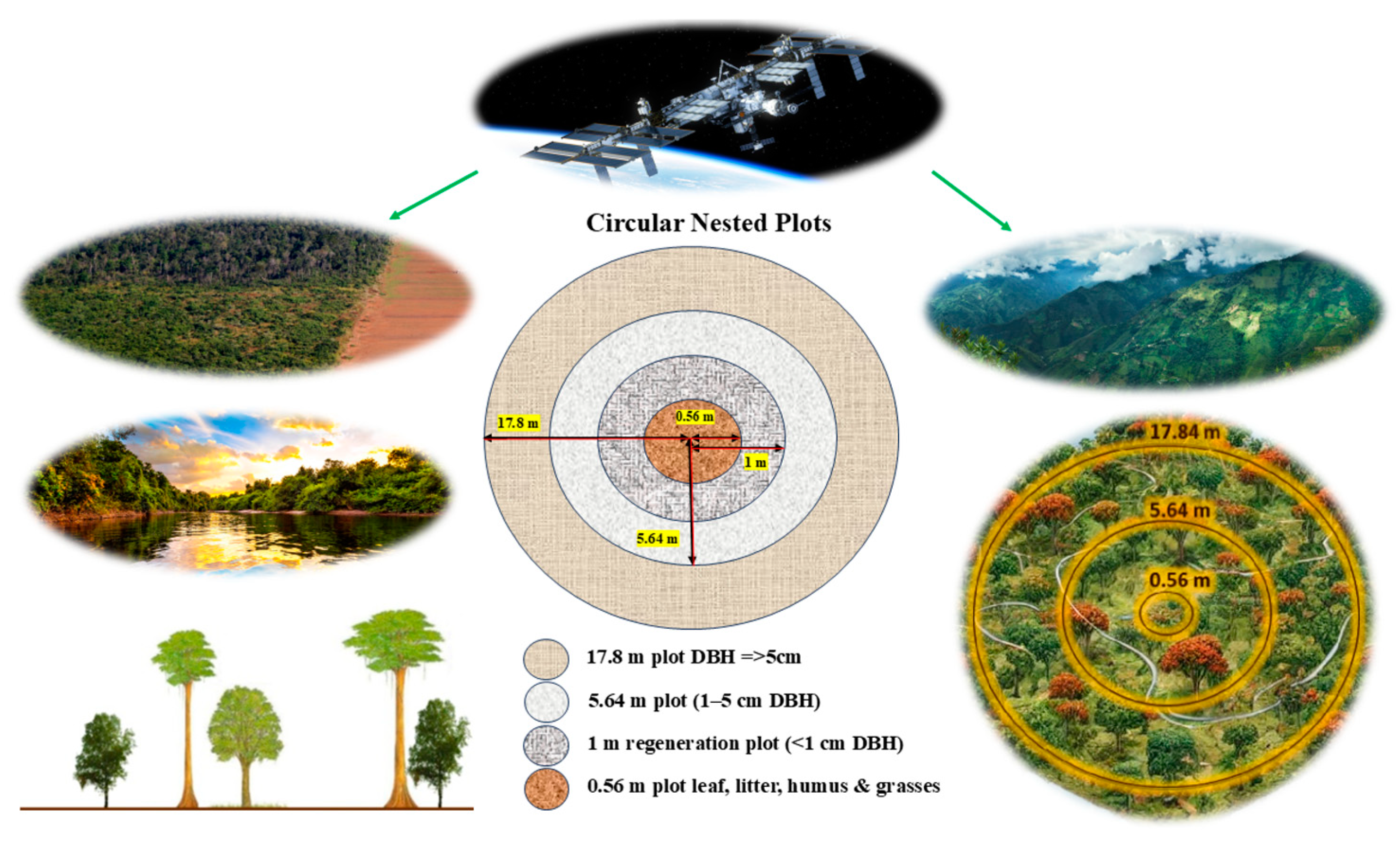
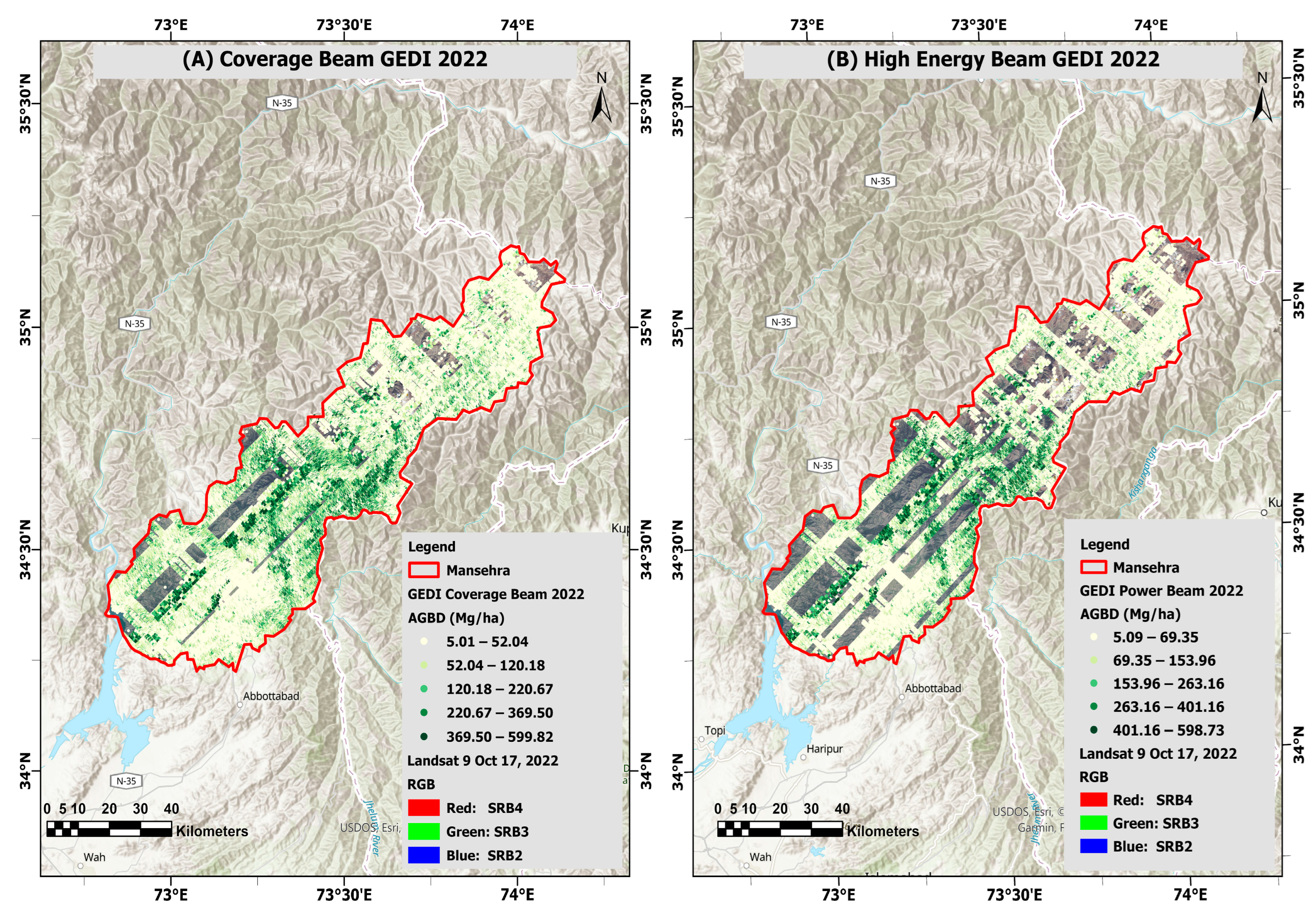
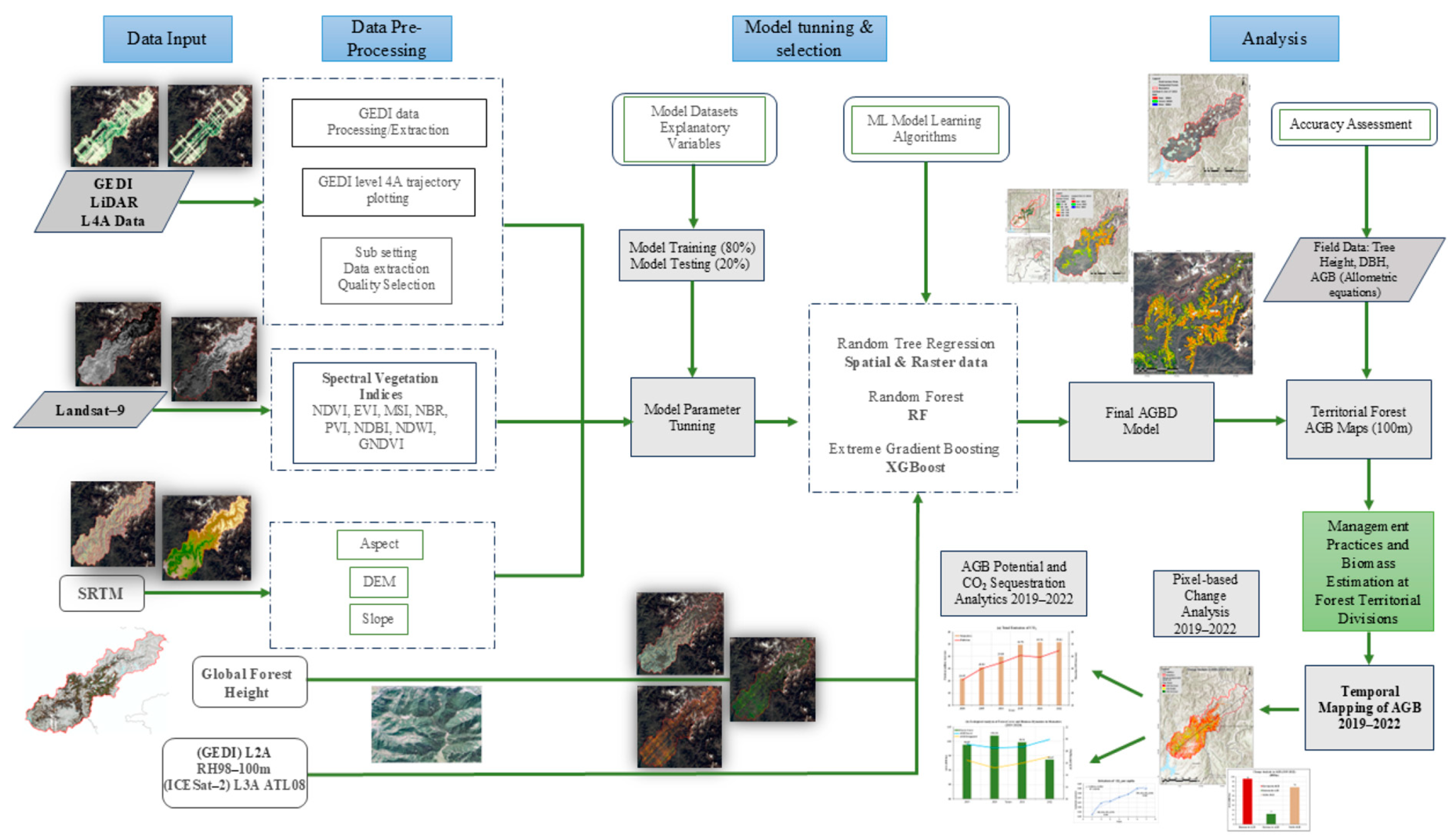
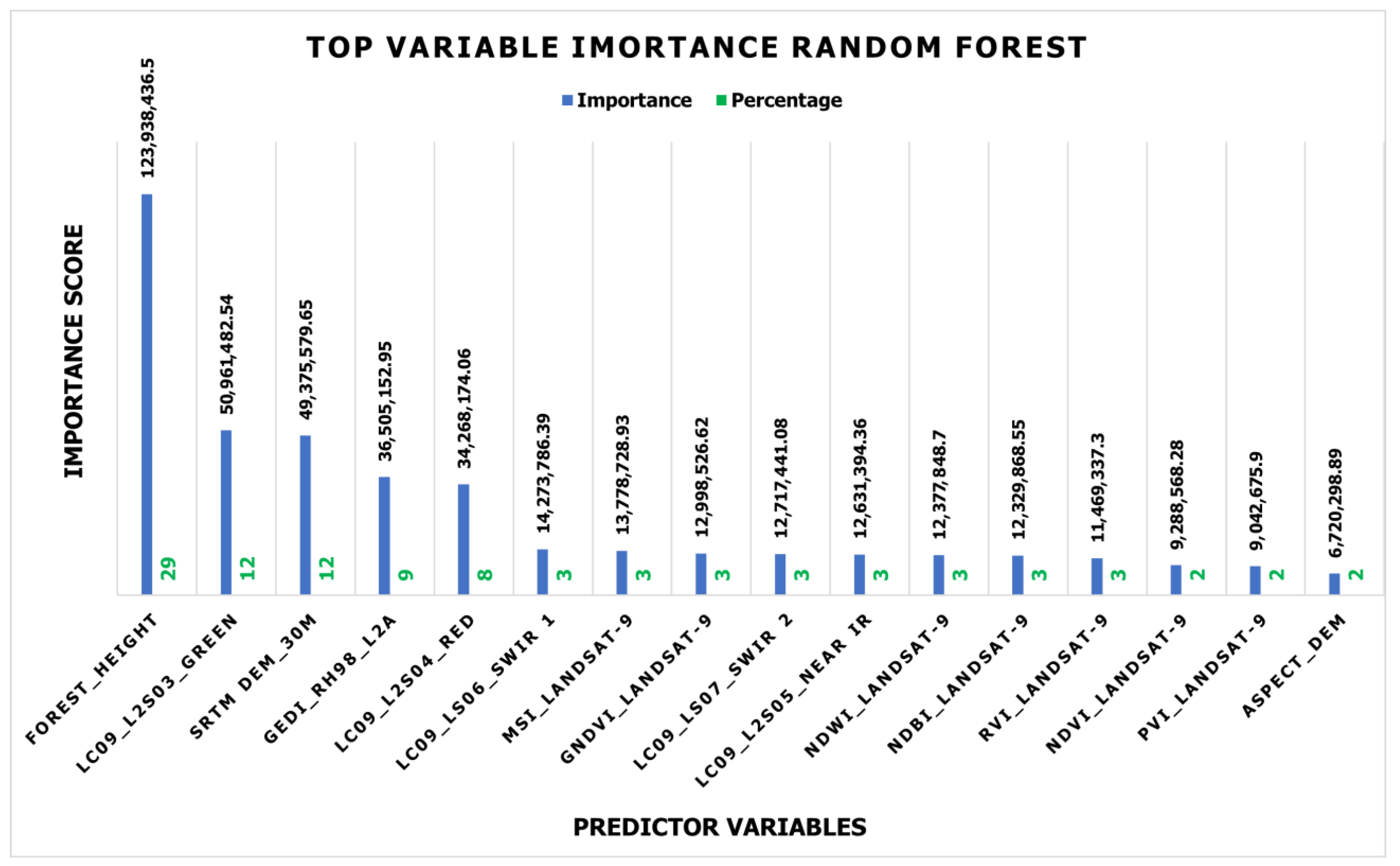
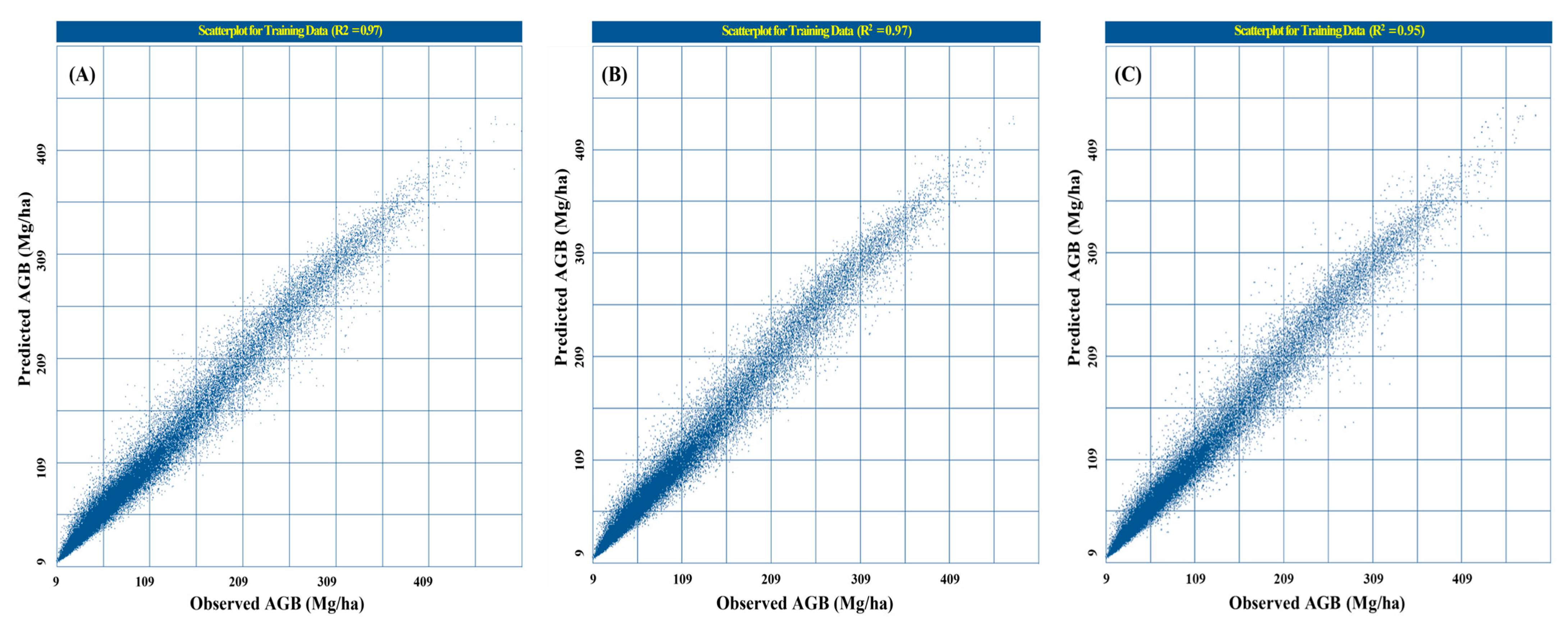
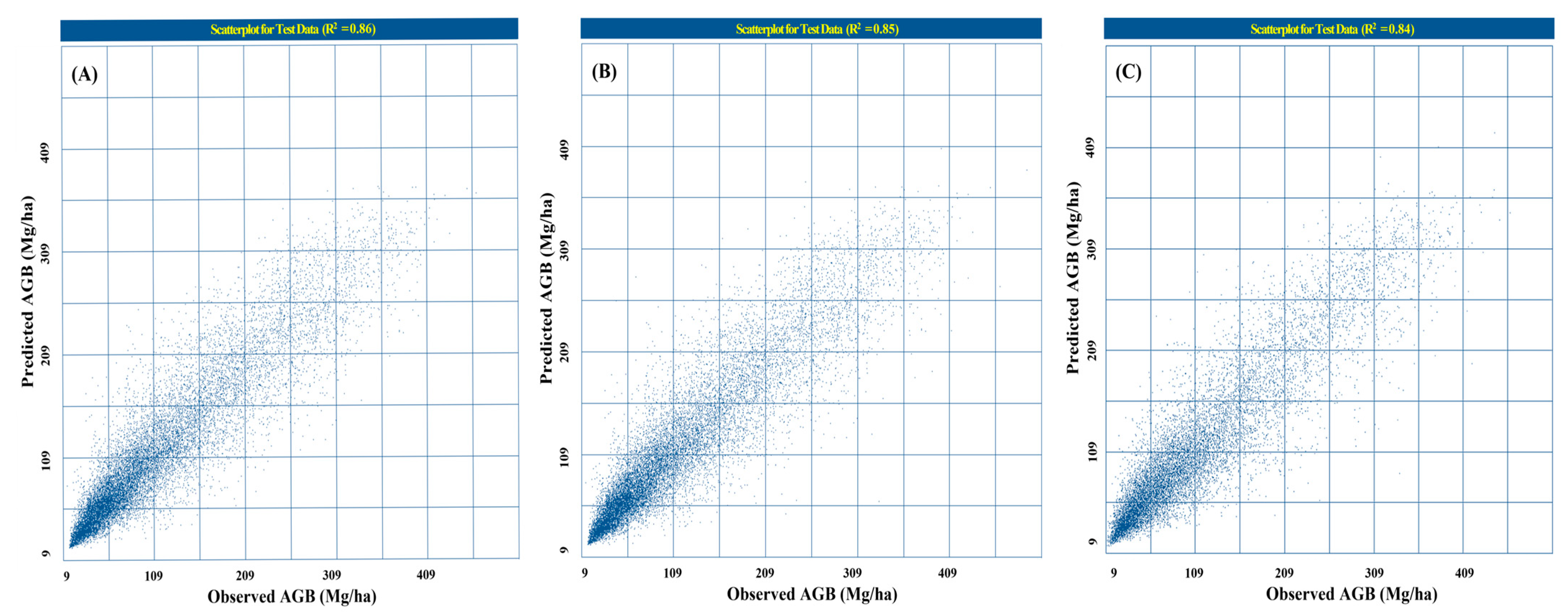

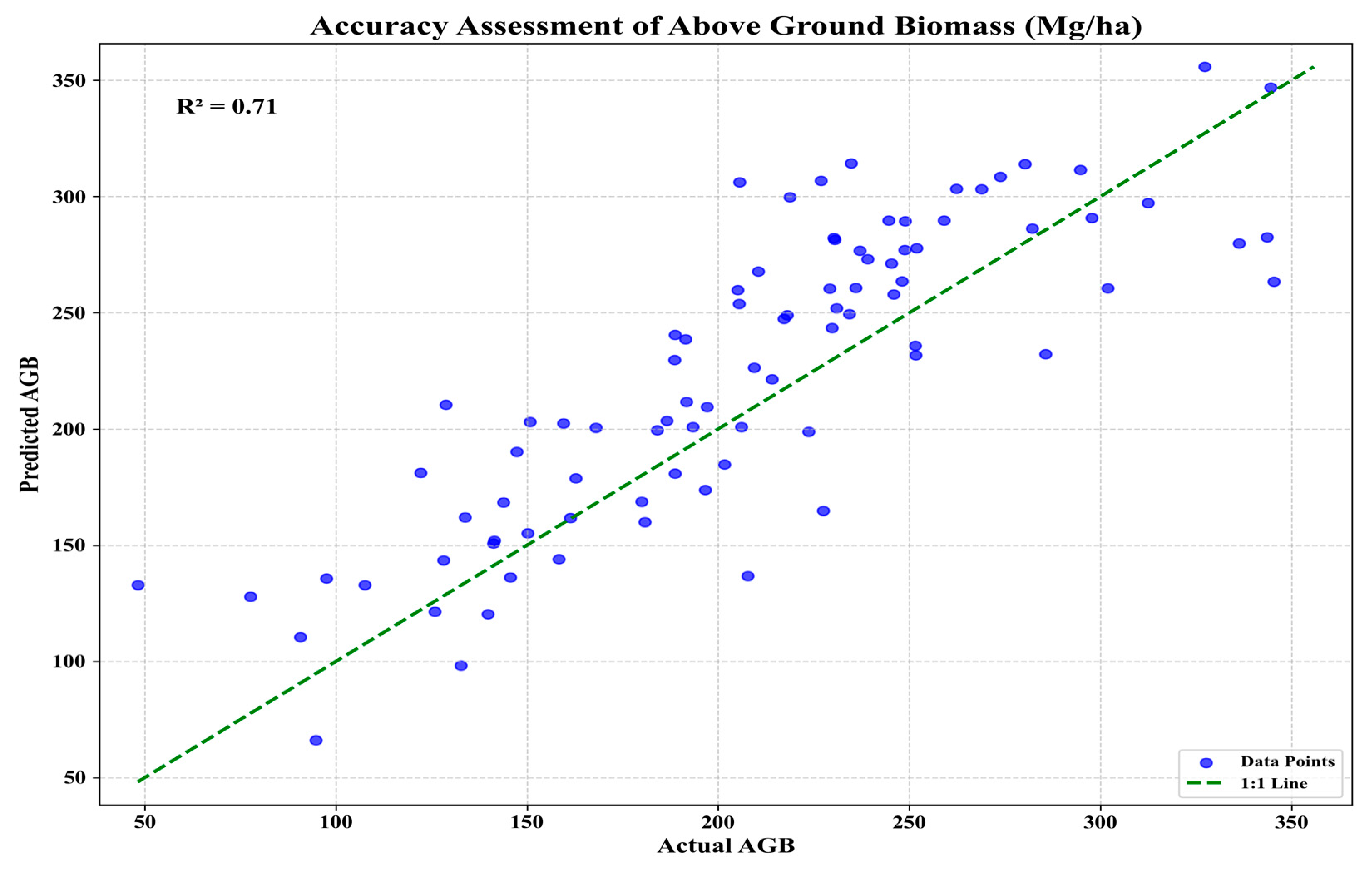
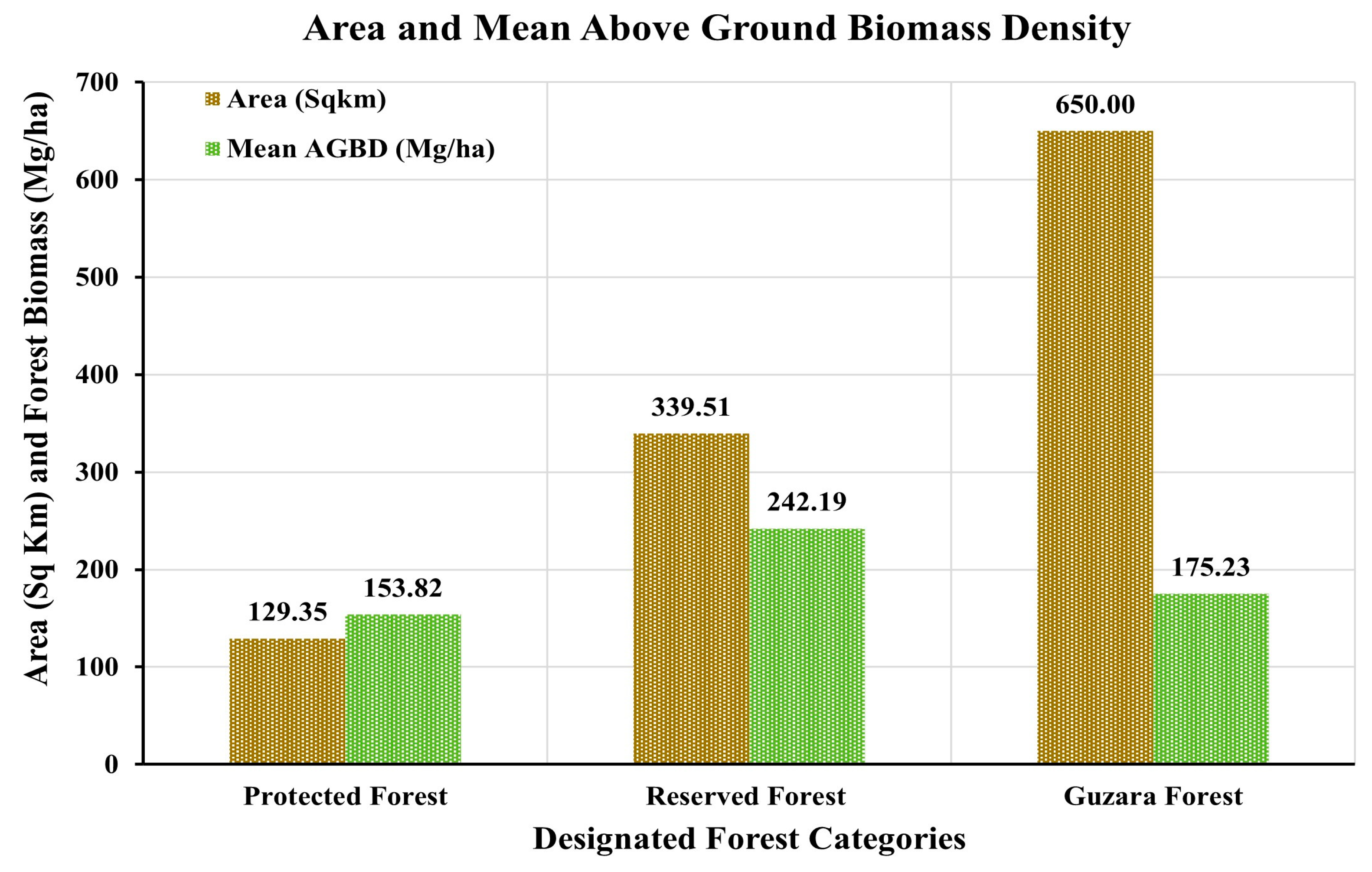
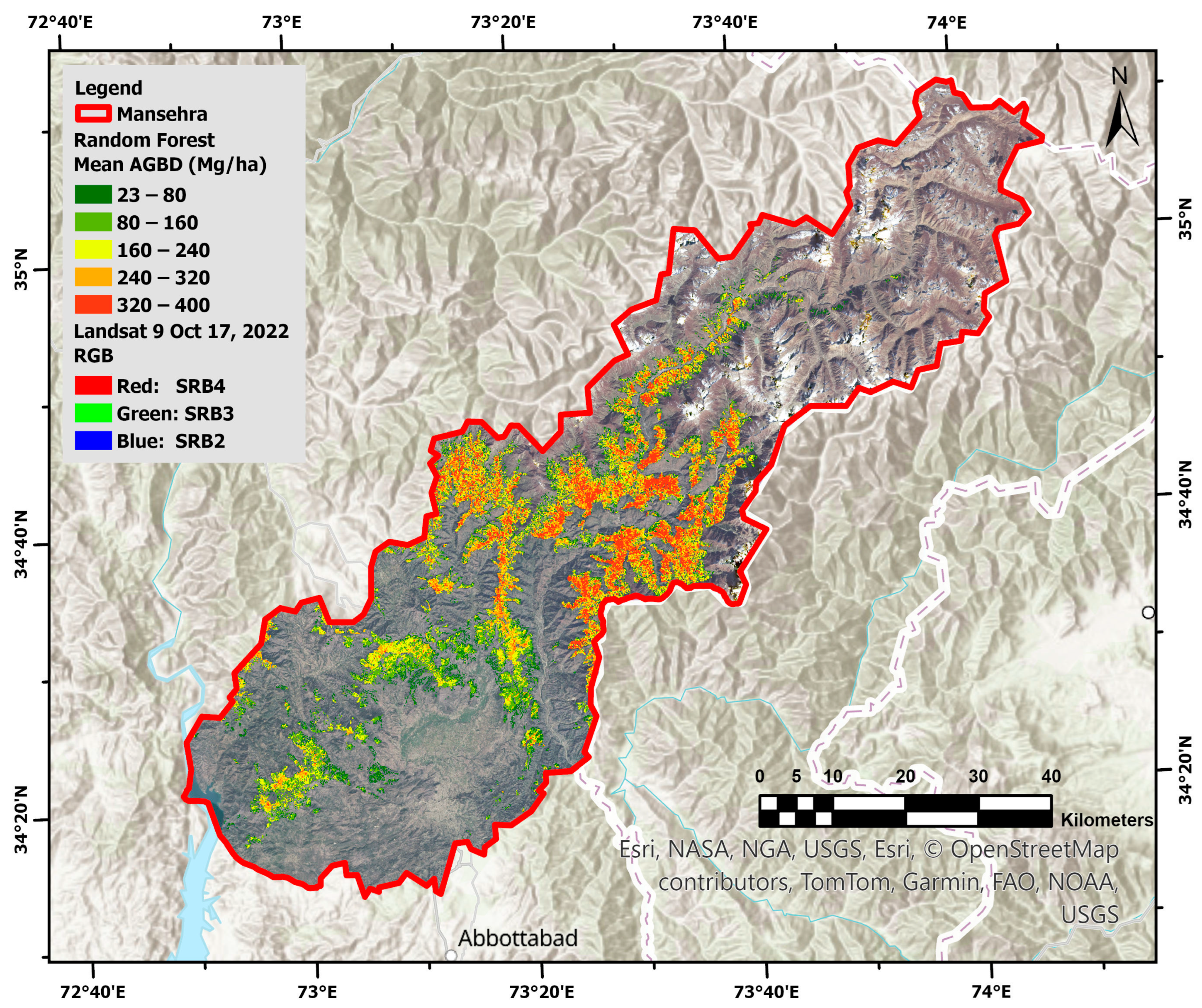

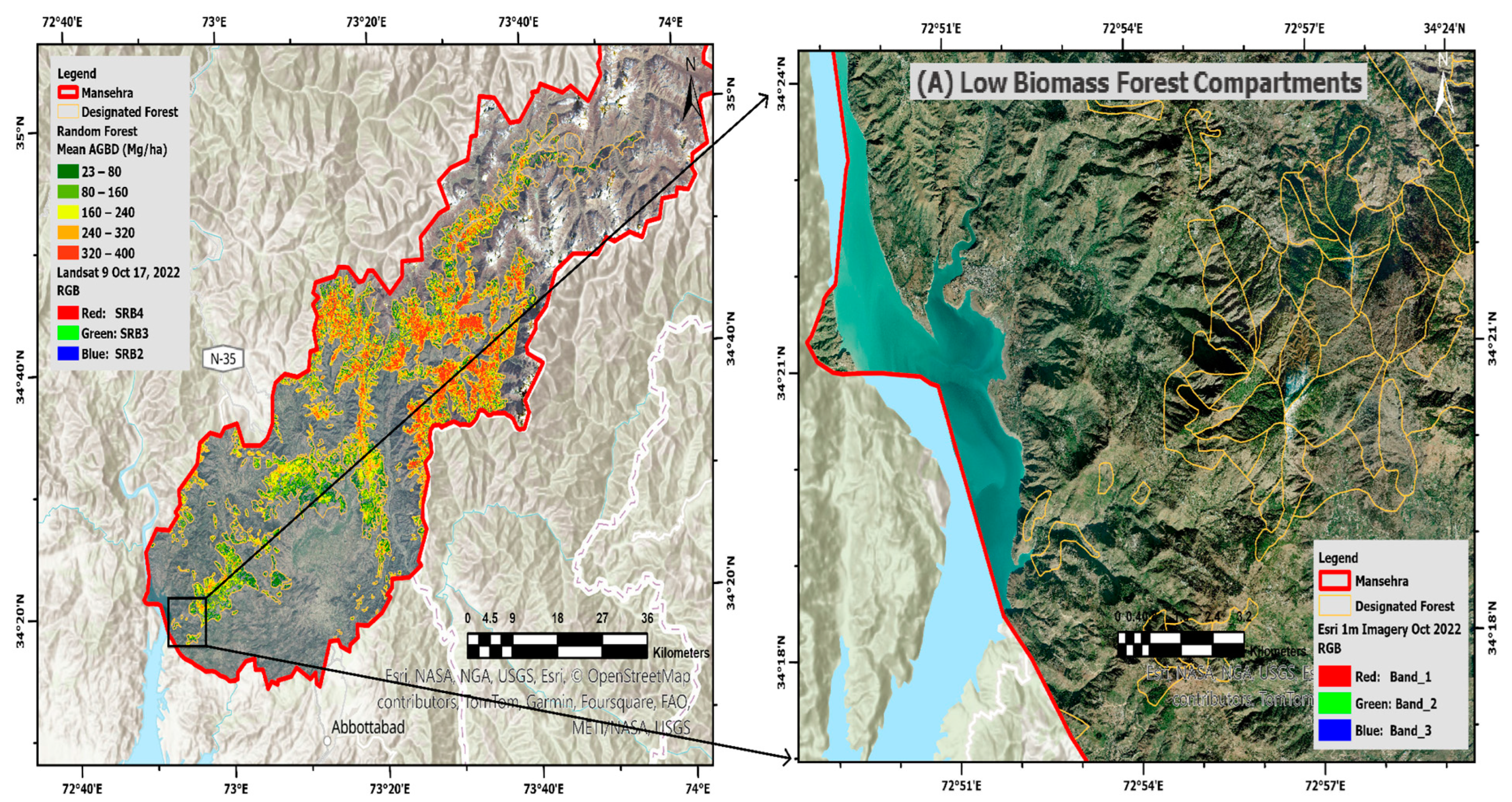
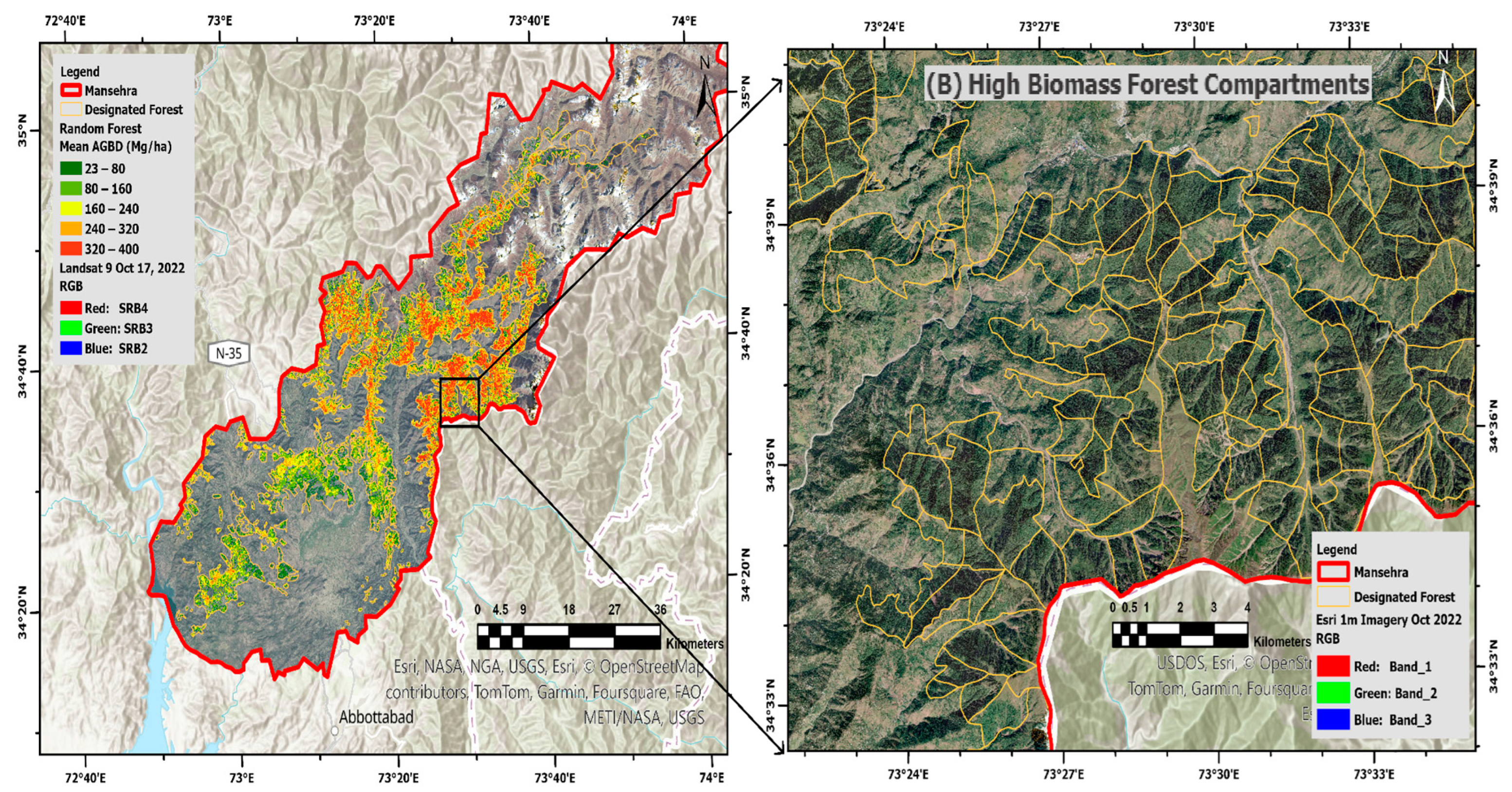
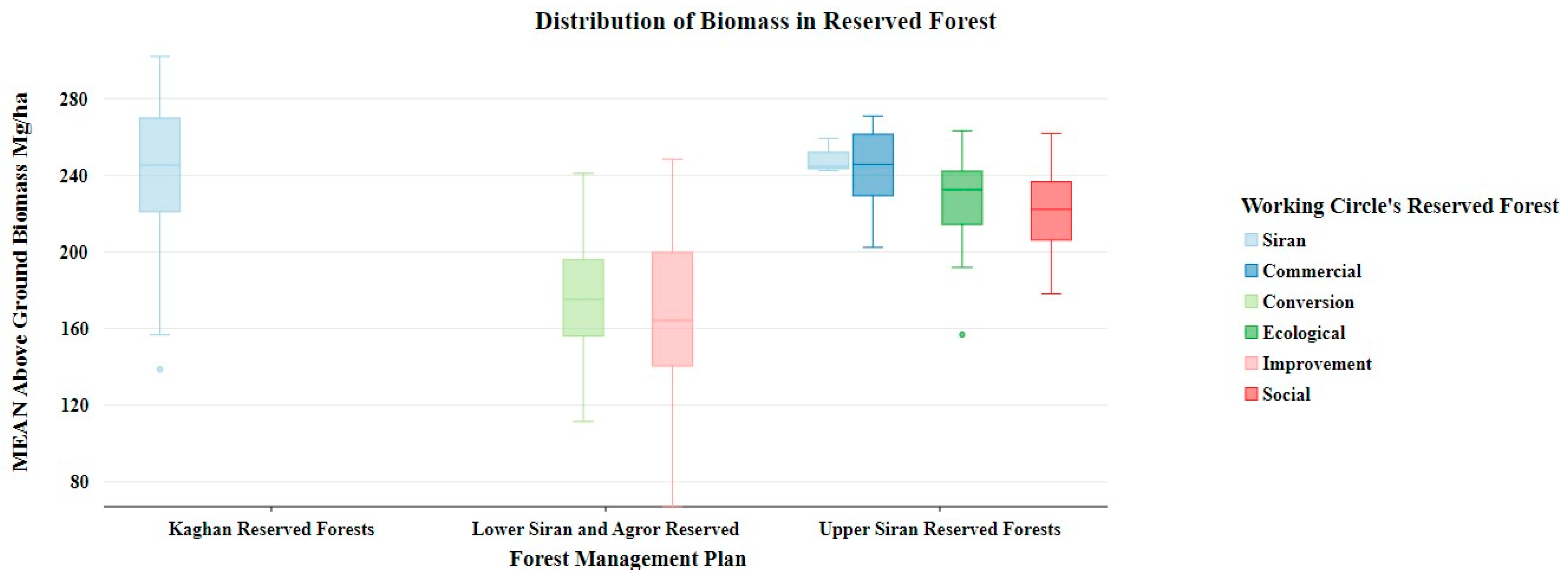

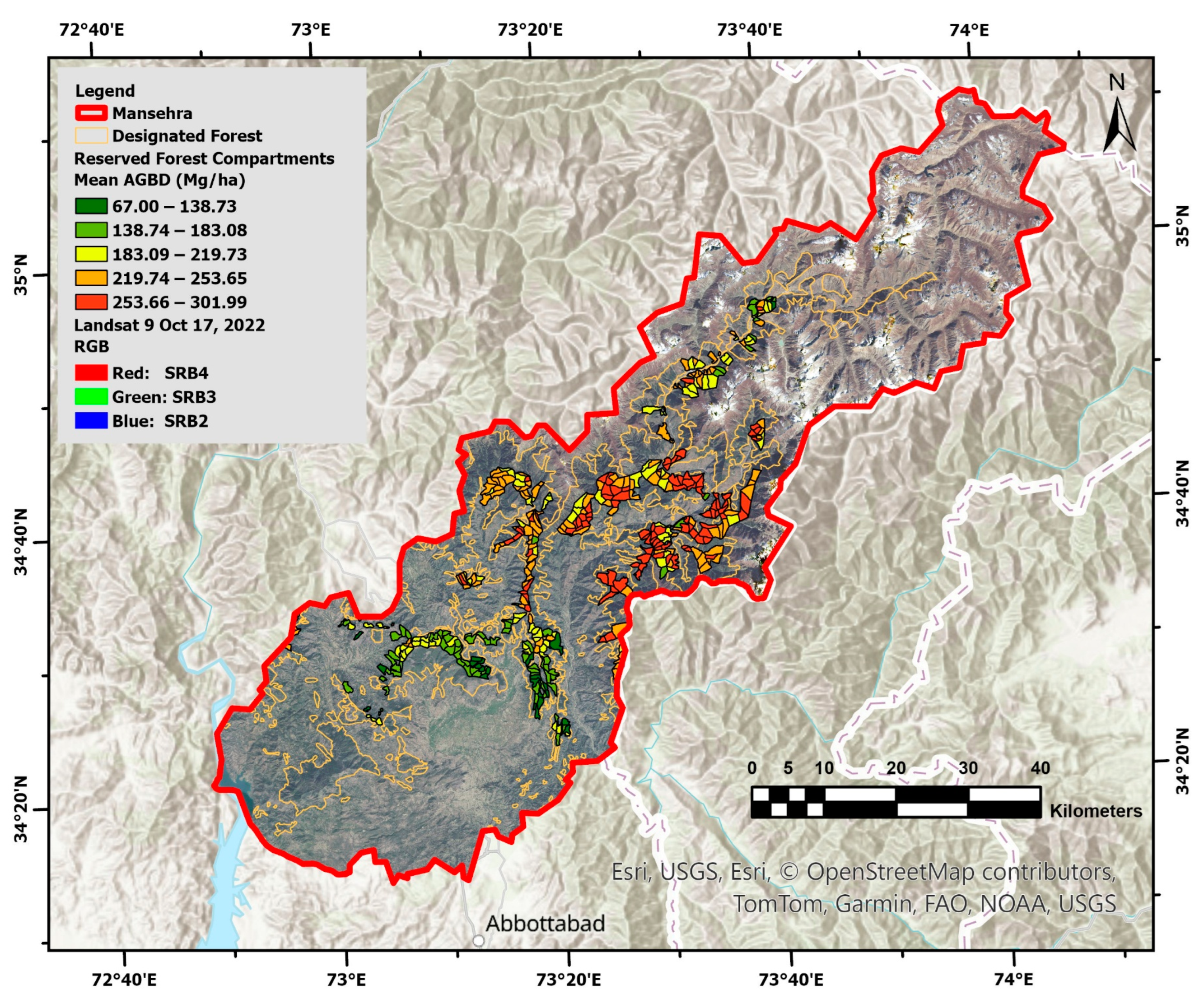
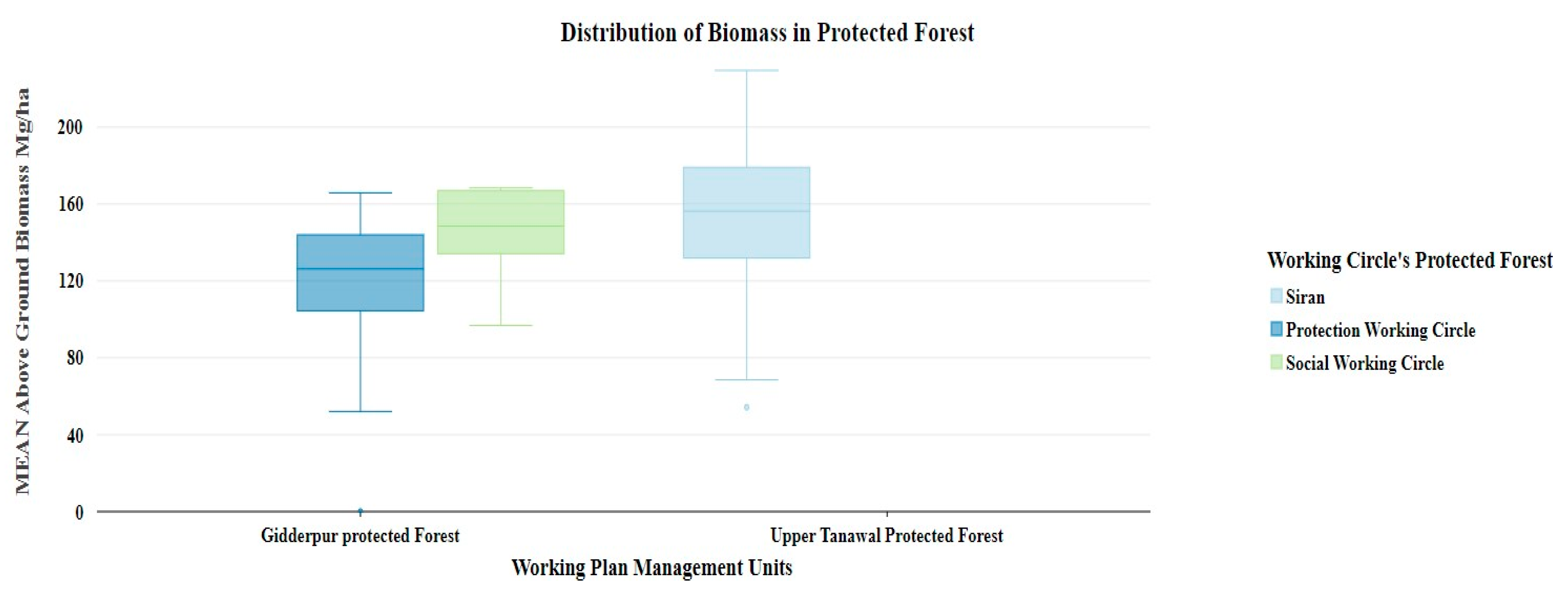
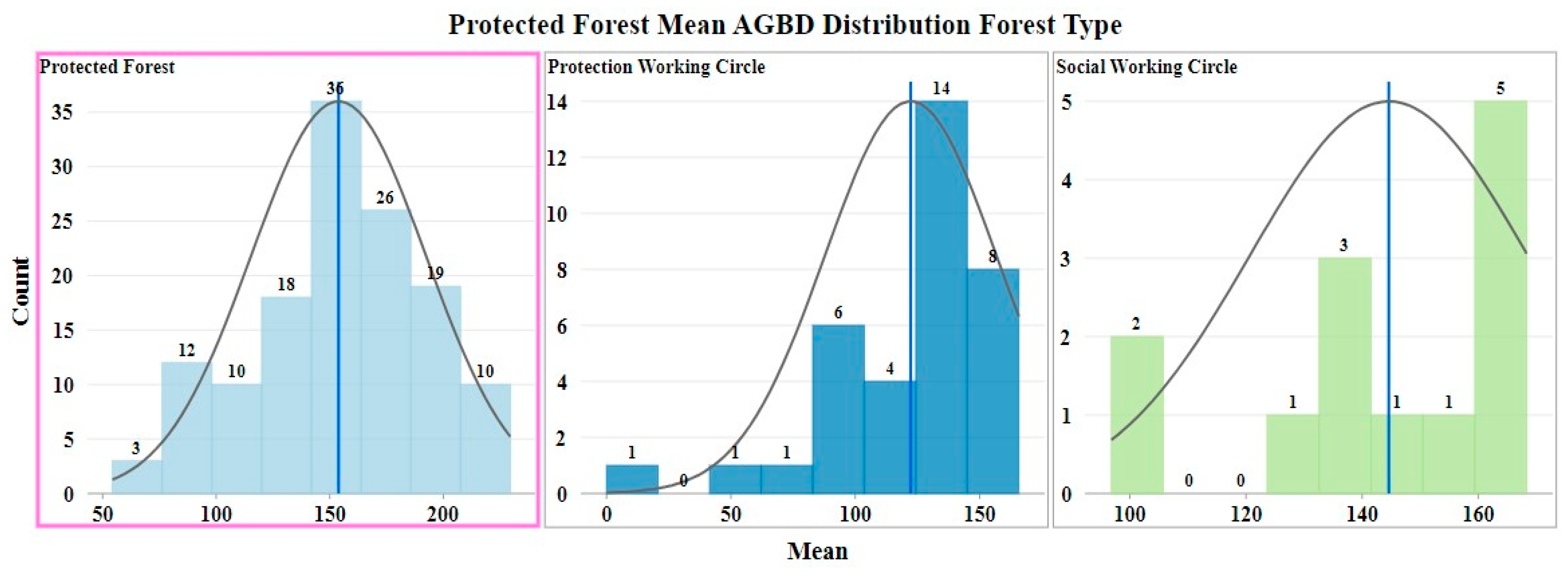
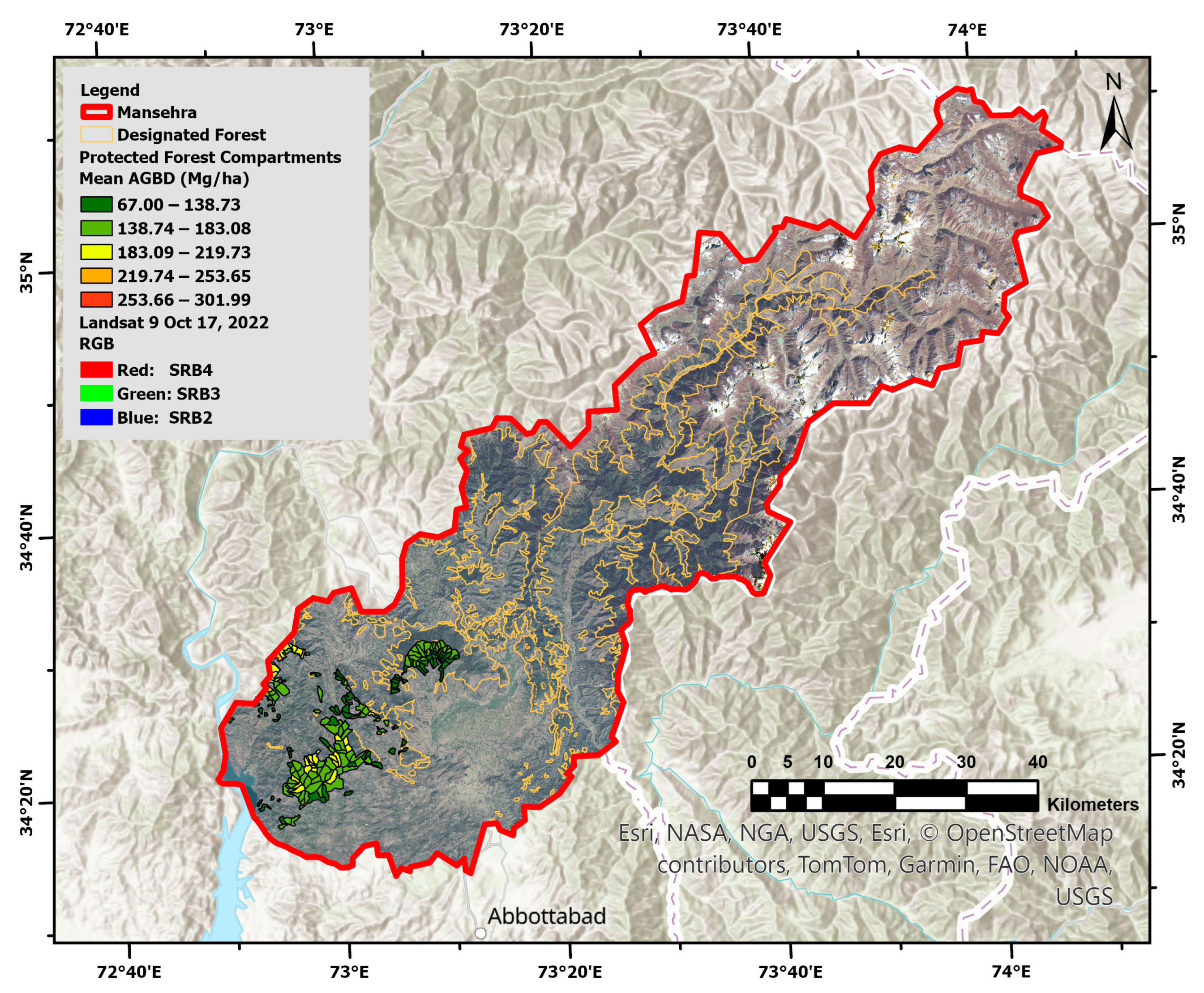
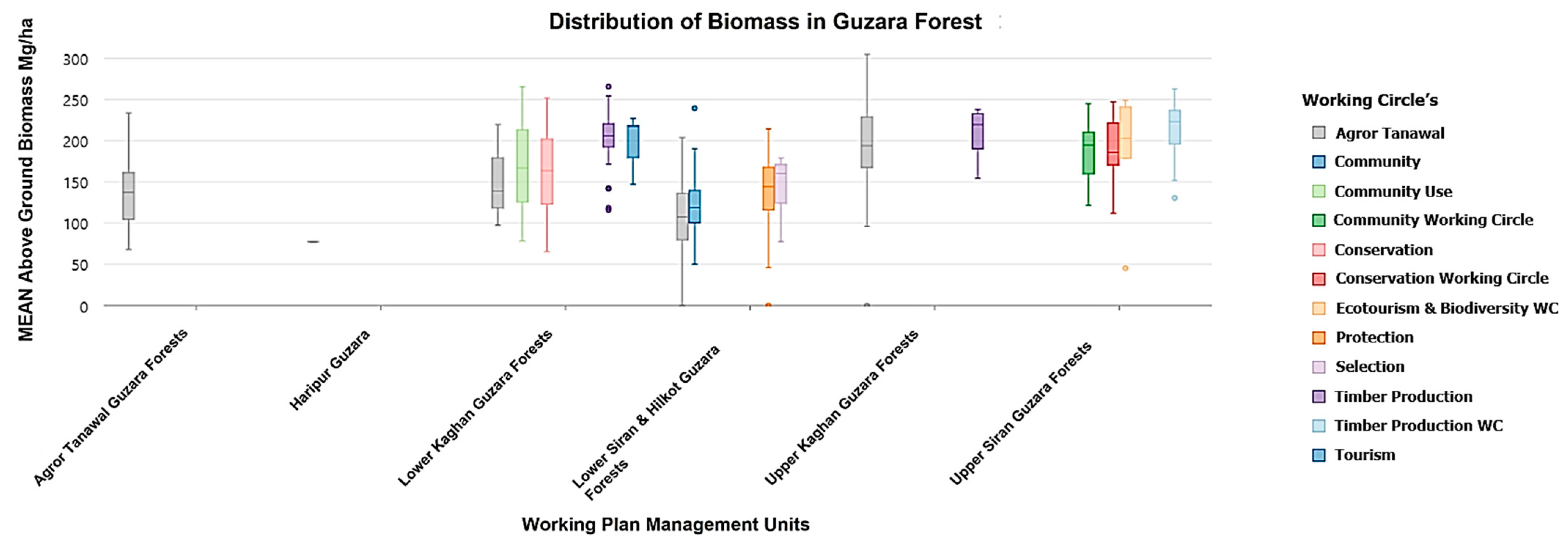
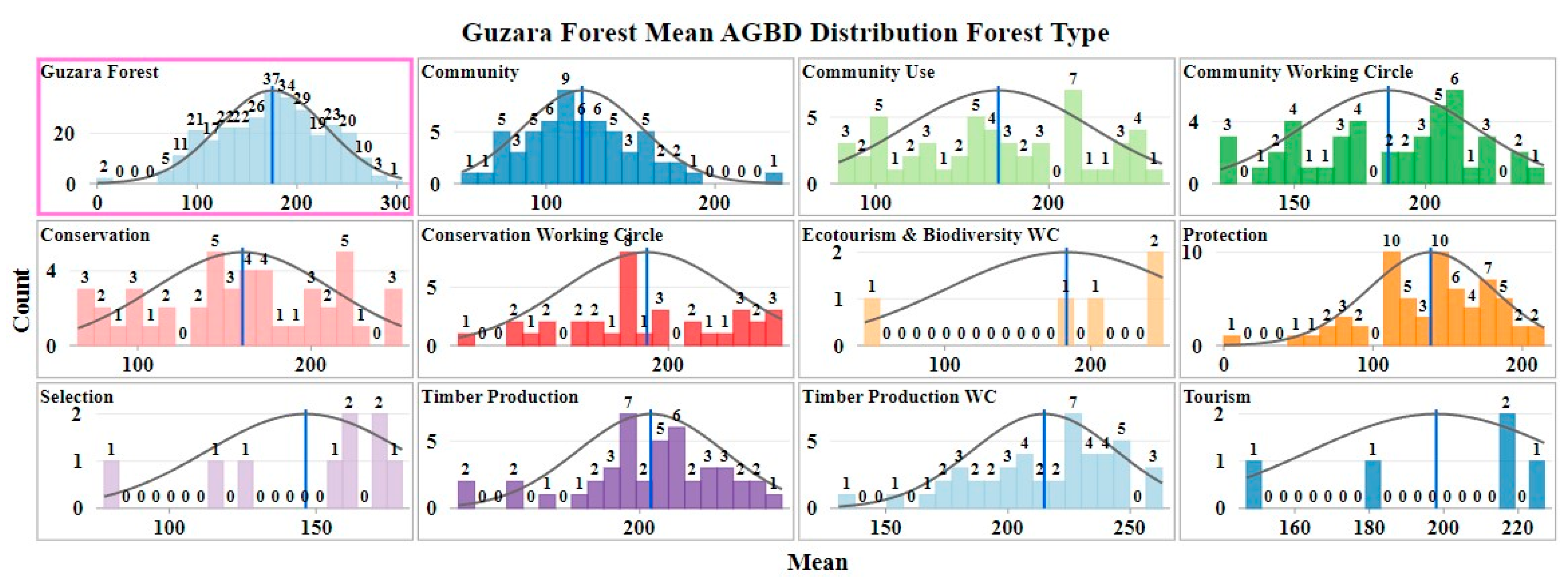
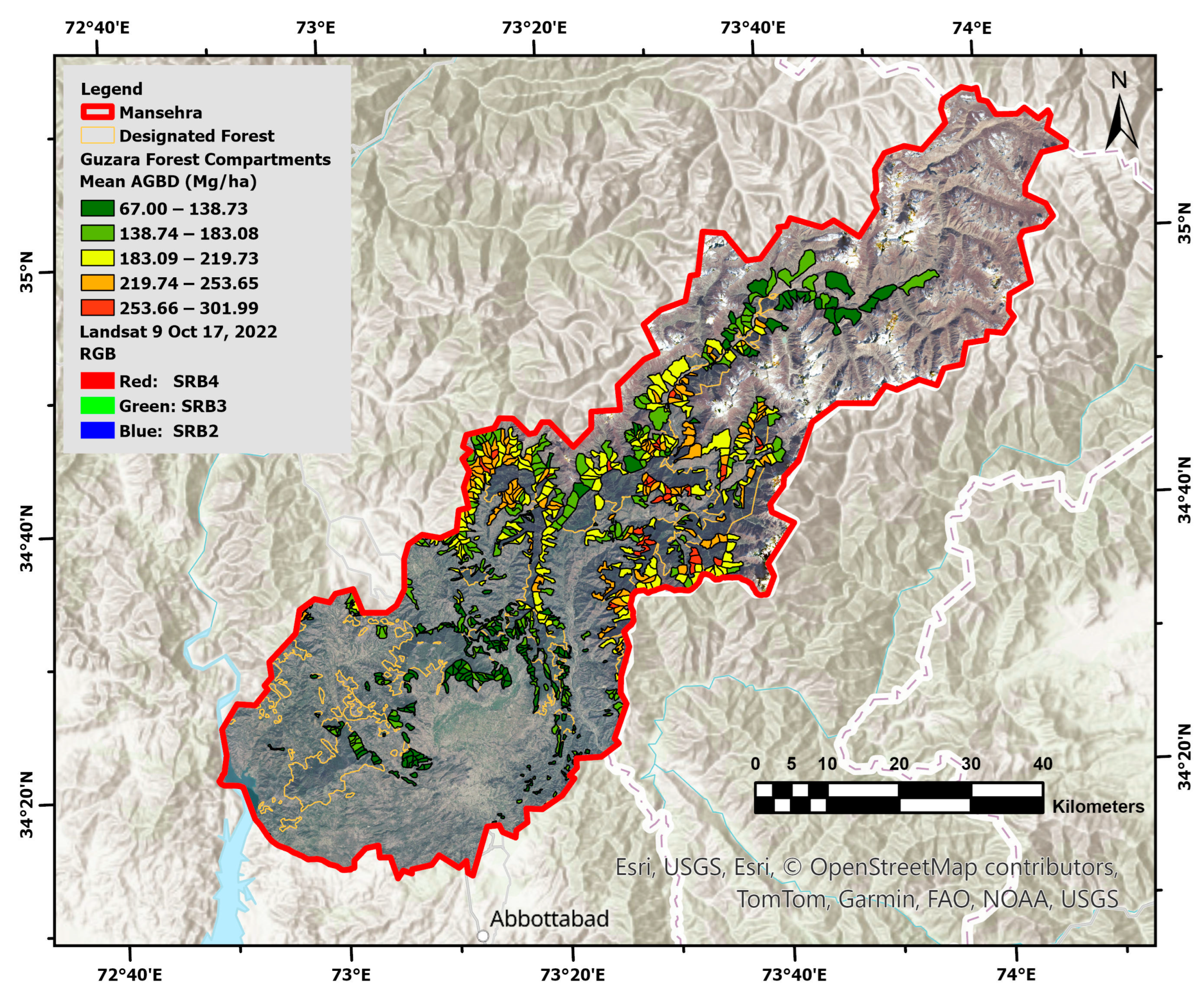
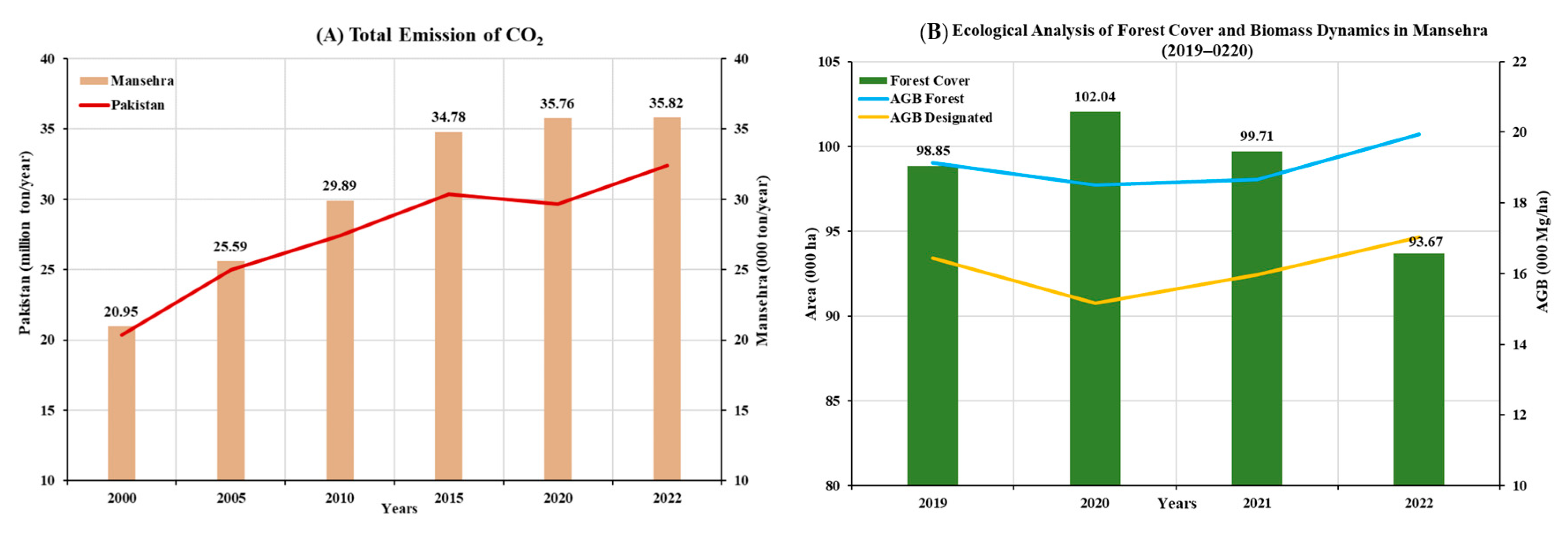

| Species | Forest Type | Allometric Equations | Model | Source |
|---|---|---|---|---|
| Quercus ilex L. (oak) | Dry temperate | AGB = 0.8277(D2H)0.6655 | M = a(D2H)b | [38] |
| Cedrus deodara (Roxb. Ex Lamb.) G. Don (deodar) | Dry temperate | AGB = 0.1779(D2H)0.8103 | M = a(D2H)b | |
| Pinus wallichiana A.B.Jackson (kail) | Dry temperate | AGB = 0.0631(D2H)0.8798 | M = a(D2H)b | |
| Cedrus deodara (Roxb. Ex Lamb.) G. Don (deodar) | Moist temperate | AGB = 0.0491(D2H)0.9167 | M = a(D2H)b | |
| Abies Pindrow Royle (fir) | Temperate | AGB = 0.0452(D2H)0.9029 | M = a(D2H)b | |
| Picea smithiana (Wall.) Boiss (spruce) | Temperate | AGB = 0.0821(D2H)0.8363 | M = a(D2H)b | |
| Pinus wallichiana A.B.Jackson (kail) | Moist temperate | AGB = 0.0594(D2H)0.881 | M = a(D2H)b | |
| Pinus roxburghii Sargent (chir pine) | Sub-tropical pine | AGB = 0.0224(D2H)0.9767 | M = a(D2H)b |
| Model Name | Model Parameter Characteristics | Value |
|---|---|---|
| Random Forest | Number of Trees | 500 |
| Leaf Size | 5 | |
| Tree-Depth Range | 36–50 | |
| Mean Tree Depth | 40 | |
| % of Training Available per Tree | 100 | |
| Number of Randomly Sampled Variables | 5 | |
| Training and Test data % | 80:20 | |
| Model Out-of-Bag Error | 805.9 | |
| Gradient Boosting | Number of Trees | 500 |
| Leaf Size | 5 | |
| Tree-Depth Range | 6–6 | |
| Mean Tree Depth | 6 | |
| % of Training Available per Tree | 100 | |
| Number of Randomly Sampled Variables | 5 | |
| % of Training Data Excluded for Validation | 20 | |
| L2 Regularization (Lambda) | 1.00 | |
| Minimum Loss Reduction for Splits (Gamma) | 0.00 | |
| Learning Rate (Eta) | 0.30 | |
| Random Tree Regression | Training Options: | |
| Maximum Number of Trees | 500 | |
| Maximum Tree Depth | 30 | |
| Maximum Number of Samples | 74,400 | |
| Percent of Samples for Testing | 20 |
| Model Name | Training | Test | ||||
|---|---|---|---|---|---|---|
| R2 | RMSE | MAE | R2 | RMSE | MAE | |
| Random Forest | 0.97 | 11.84 | 8.08 | 0.86 | 28.03 | 19.54 |
| XGBoost | 0.95 | 15.72 | 11.20 | 0.85 | 29.35 | 20.57 |
| Random Tree Regression | 0.97 | 14.38 | 10.98 | 0.84 | 31.22 | 21.76 |
| Year | Mansehra (Values in Thousand Tons) | Pakistan (Values in Million Tons) | ||
|---|---|---|---|---|
| CO2 Emissions | AGB Requirement | CO2 Emissions | AGB Requirement | |
| 2000 | 20.95 | 12.14 | 20.35 | 11.80 |
| 2005 | 25.59 | 14.83 | 24.99 | 14.49 |
| 2010 | 29.89 | 17.33 | 27.43 | 15.90 |
| 2015 | 34.78 | 20.16 | 30.38 | 17.61 |
| 2020 | 35.76 | 20.73 | 29.66 | 17.20 |
| 2022 | 35.82 | 20.77 | 32.39 | 18.78 |
| Region | Data | Techniques | Mean AG (B/C)*/R2 | Ref |
|---|---|---|---|---|
| Himalayan moist temperate forest, Uttarakhand, India | Sentinel-1 and -2 and GEDI forest canopy height | RF1 Algorithm | AGB 190.27 Mg ha−1/0.88 | [71] |
| NW Indian Himalayan foothills | ICESat-2 and Sentinel-1 FCH | RF model | AGB 426.41 Mg ha−1/0.83 | [26] |
| Xiaoshao, Yiliang Yunnan Province China | Sentinel-1 and -2, ALOS PALSAR-2, and GEDI L4A | RF model | AGB 59.09 Mg ha−1/0.72 | [51] |
| Biomass estimation in managed forests, Haldwani India | Forest layer, field data, and GEDI canopy height | MLR2 models | AGB 153 Mg ha−1/0.75 | [11] |
| Region | Data | Techniques | Mean AG (B/C)*/R2 | Ref |
|---|---|---|---|---|
| Western Himalayan Indian forest | MODIS and L-band ALOS-PALSAR | RF1 Regression | AGB 180.27 Mg ha−1/0.77 | [72] |
| Sub-tropical chir pine forest, Margalla Hill, Pakistan | DBH and height | Linear Regression | AGC 73.36 ± 32.55 Mg C ha−1 | [73] |
| Battagram KP, Pakistan | Sentinel-2 vegetation indices | Linear Regression | AGB 148.79 t ha−1/0.67 | [16] |
| Temperate and sub-tropical forests, KP, Pakistan | Spot-5 satellite (2.5 m) | Allometric Equations | AGC 85.05 ± 10.84 t ha−1 | [38] |
| Pinus roxburghii forest in Siran forest divsion, Pakistan | Landsat-8 (spectral indices) | Linear Regression | AGC 26–116 t ha−1/0.63 | [74] |
Disclaimer/Publisher’s Note: The statements, opinions and data contained in all publications are solely those of the individual author(s) and contributor(s) and not of MDPI and/or the editor(s). MDPI and/or the editor(s) disclaim responsibility for any injury to people or property resulting from any ideas, methods, instructions or products referred to in the content. |
© 2025 by the authors. Licensee MDPI, Basel, Switzerland. This article is an open access article distributed under the terms and conditions of the Creative Commons Attribution (CC BY) license (https://creativecommons.org/licenses/by/4.0/).
Share and Cite
Imran, M.; Zhou, G.; Jing, G.; Xu, C.; Tan, Y.; Ishaq, R.A.F.; Lodhi, M.K.; Yasinzai, M.; Akbar, U.; Ali, A. Assessing Above-Ground Biomass Dynamics and Carbon Sequestration Potential Using Machine Learning and Spaceborne LiDAR in Hilly Conifer Forests of Mansehra District, Pakistan. Forests 2025, 16, 330. https://doi.org/10.3390/f16020330
Imran M, Zhou G, Jing G, Xu C, Tan Y, Ishaq RAF, Lodhi MK, Yasinzai M, Akbar U, Ali A. Assessing Above-Ground Biomass Dynamics and Carbon Sequestration Potential Using Machine Learning and Spaceborne LiDAR in Hilly Conifer Forests of Mansehra District, Pakistan. Forests. 2025; 16(2):330. https://doi.org/10.3390/f16020330
Chicago/Turabian StyleImran, Muhammad, Guanhua Zhou, Guifei Jing, Chongbin Xu, Yumin Tan, Rana Ahmad Faraz Ishaq, Muhammad Kamran Lodhi, Maimoona Yasinzai, Ubaid Akbar, and Anwar Ali. 2025. "Assessing Above-Ground Biomass Dynamics and Carbon Sequestration Potential Using Machine Learning and Spaceborne LiDAR in Hilly Conifer Forests of Mansehra District, Pakistan" Forests 16, no. 2: 330. https://doi.org/10.3390/f16020330
APA StyleImran, M., Zhou, G., Jing, G., Xu, C., Tan, Y., Ishaq, R. A. F., Lodhi, M. K., Yasinzai, M., Akbar, U., & Ali, A. (2025). Assessing Above-Ground Biomass Dynamics and Carbon Sequestration Potential Using Machine Learning and Spaceborne LiDAR in Hilly Conifer Forests of Mansehra District, Pakistan. Forests, 16(2), 330. https://doi.org/10.3390/f16020330








